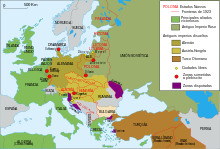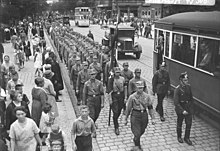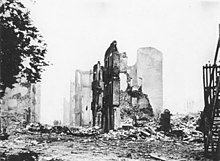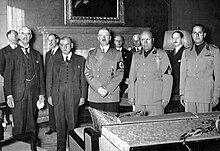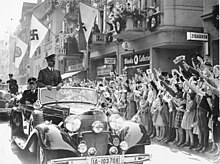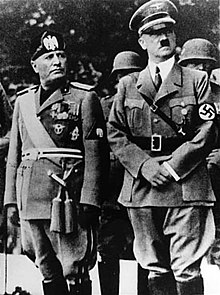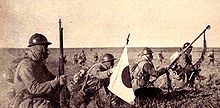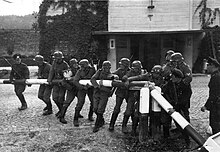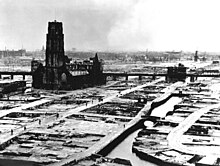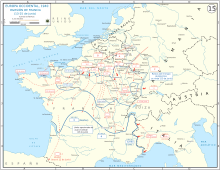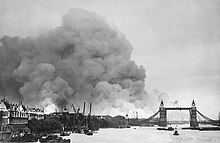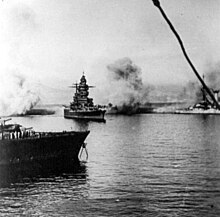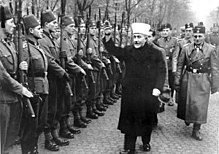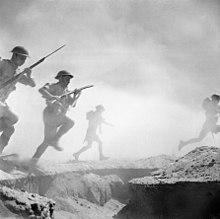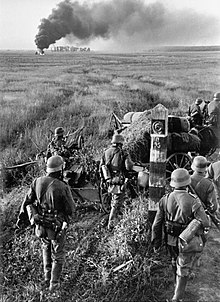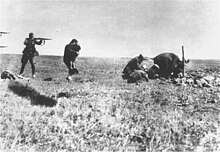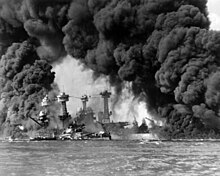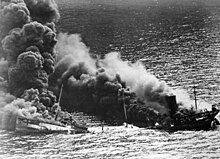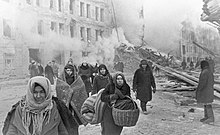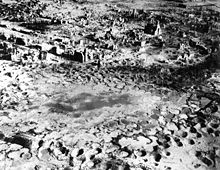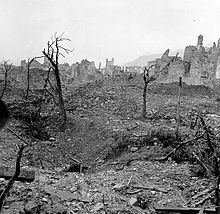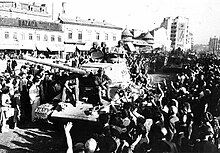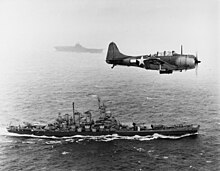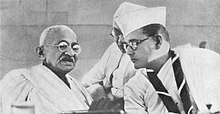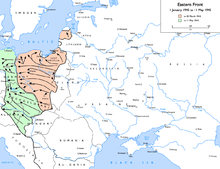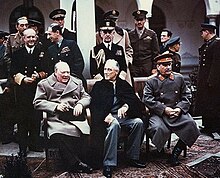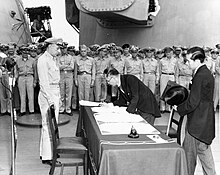Second World War
The World War II was a global military conflict that took place between 1939 and 1945. It involved most of the world's nations (including all the great powers, as well as virtually all European nations) grouped into two warring military alliances: The Allies, on the one hand, and the Axis powers, on the other. It was the largest war in history, with more than 100 million soldiers mobilized and a state of total war in which the major contenders devoted all their economic, military, and scientific capacity to the service of the war effort, blurring the distinction between civilian and military. Marked by events of enormous repercussion that included the massive death of civilians (the Holocaust, the intensive bombing of cities and the use, for the first time in a military conflict, of nuclear weapons), the Second World War was the deadliest in history., with a result of between 50 and 70 million victims, 2.5% of the world population.
The beginning of the conflict is usually placed on September 1, 1939, with the German invasion of Poland, when Hitler decided to incorporate one of his most delicate expansionist demands: The Polish Corridor, which implied the invasion of the western half of Poland; the eastern half, along with Estonia, Latvia and Lithuania, was occupied by the Soviet Union, while Finland managed to maintain its independence from the Soviets (Winter War). The UK and France declared war on Germany, which they expected as a repeat of the trench warfare (“lie war”) for which they had taken all kinds of precautions (Maginot line) that proved to be completely useless. The spectacular maneuvers of the blitzkrieg ("lightning war") gave Germany control of Norway, Denmark, the Netherlands, Belgium and France itself in a few months, while the army British escaped in extremis from the beaches of Dunkirk during the battle of France. Most of the European continent was occupied by the German army or by its allies, among which Fascist Italy stood out, whose military contribution was not very significant (battle of the Alps, Greco-Italian war).
The Battle of Britain, the first completely aerial battle in history, maintained pressure on the new government of Winston Churchill for the following period, determined to resist ("blood, sweat and tears") and which finally won, among other things thanks to a technological innovation (radar) and decisive US support, which he negotiated in various interviews with Franklin D. Roosevelt (Atlantic Charter, August 14, 1941).
In 1941, the strategic need to occupy the oil fields of the Caucasus prompted Germany to invade the Soviet Union (operation Barbarossa), initially successful, but which stalled in the battle of Moscow and the sieges of Leningrad and Stalingrad. At the same time, Japan, in its expansion campaign for Asia and in revenge for the economic embargo that the US government had imposed on them, attacked Pearl Harbor on December 7, 1941; the aggression precipitated the entry of the United States into the war. A few months later, the Battle of Midway (in July 1942) would mark a turning point in the Pacific War due to the weakening of the Japanese combat capacity against the Americans. In North Africa, the British stopped the advance of the German Afrika Korps from Libya towards Egypt in the battle of El Alamein (1942), after the Italian invasion of the Suez Canal (1940).
The final period of the war was characterized by the complex operations necessary for the Allied landings in Europe (Sicily, in July 1943; Anzio, in January 1944; Normandy, in June 1944) and by the collapse of the front on the eastern front, in which the fiercest tank operations in history were fought (battle of Kursk, especially at Prokhorovka, July 1943), while on the western front the Germans experimented with highly developed technological weapons (V-1 and V-missiles). 2) and endured destructive bombardments of their cities on a scale never seen before (bombardment of Dresden, in February 1945) and the total destruction of their capital (Battle of Berlin, between April and May 1945).
On the Pacific front, the Americans had to evict the Japanese island by island, both in the South Pacific (Guadalcanal, in August 1942) and in the Philippines (Manila, in February 1945); After fighting the biggest naval battles in history (Battle of the Coral Sea, in May 1942; Battle of Leyte Gulf, in October 1944), they reached Japanese lands (Iwo Jima, in February 1945 and Okinawa, in April 1945). In August 1945, US President Harry S. Truman ordered the cities of Hiroshima and Nagasaki to be bombarded with newly invented nuclear weapons. The devastation caused by the attack, which would eventually claim the lives of 250,000 people, precipitated Japan's capitulation.
Unlike in World War I, the surrender (both the Japanese and the German) took place by unconditional defeat, without going through any kind of negotiation. The decisive talks were those that raised the division of Europe into areas of influence between the allies, and that were negotiated in successive summits (Tehran conference, December 1, 1943; Yalta conference, in February 1945; and the Potsdam Conference in July 1945).
World War II altered the political relations and social structure of the world. After the conflagration, the United Nations Organization was founded in order to promote international cooperation and prevent potential conflicts. The Soviet Union and the United States emerged as rival superpowers, setting the stage for the Cold War, which lasted for the next 46 years. At the same time, the influence of the great European powers declined, materialized in the beginning of the decolonization of Asia and Africa. Most of the countries whose industries had been hurt undertook economic recovery with the financial help of the American countries (Marshall plan), while political integration emerged as an effort to establish postwar relations.
Timeline
The war in Europe is generally considered to have begun on 1 September 1939 with the German invasion of Poland, which led to the declaration of war by the United Kingdom and France on Germany two days later. The start dates of the hostilities in the Pacific Ocean area are several and earlier in time: The Second Sino-Japanese War that began on July 7, 1937 or even the Japanese invasion of Manchuria from September 19 from 1931.
Others agree with British historian A. J. P. Taylor, who argued that the Sino-Japanese War and the War in Europe and its Colonies occurred simultaneously and both broke out in 1941. Another start date sometimes used for World War II is the Italian invasion of Ethiopia from October 3, 1935. Antony Beevor, also a historian, believes that the conflagration began with the battle of Jaljin Gol between Japan and the forces of Mongolia and the Union of Soviet Socialist Republics (USSR), in May to September 1939. Conventional dating will be followed in this article.
The exact date of the end of the war is also not universally agreed upon. It has generally been accepted that the conflict ended with the Japanese armistice of August 14, 1945, rather than Japan's formal surrender, which occurred on September 2, effectively ending hostilities in Asia. A peace treaty with Japan was signed in 1951. Decades later, in 1990, a treaty on the future of Germany allowed the country's reunification and resolved many of Europe's postwar problems. Japan and the USSR never signed a formal peace treaty.
Background
The war causes of the outbreak of World War II are, in the West, the invasion of Poland by German troops and, in the East, the Japanese invasion of China, the British and Dutch colonies and later the attack on Pearl Harbor.
The Second World War broke out after these aggressive actions were responded to by a declaration of war, armed resistance, or both, by the countries attacked and those with which they maintained treaties. At first, the Allied countries consisted only of Poland, the United Kingdom and France, while the Axis forces consisted only of Germany and Italy in an alliance called the Pact of Steel. As the war progressed, the countries that were entering it (because they were attacked or had treaties with the attacked countries) aligned themselves on one of the two sides, depending on each situation. That was the case of the United States and the USSR, attacked respectively by Japan and Germany. Some countries, such as Hungary or Italy, changed their alliances in the final phases of the war.
In Europe
The Treaty of Versailles established the compensation that Germany had to pay to the victors of the First World War. The United Kingdom gained most of the German colonies in Africa and Oceania (although some went to Japan and Australia). France, on whose soil most of the fighting on the Western Front was fought, received a large financial indemnity and the recovery of Alsace and Lorraine, which had been annexed to Germany by Otto von Bismarck after the Franco-Prussian War in 1870..
In the Russian Empire, the Romanov Dynasty had been overthrown and replaced by a provisional government that was in turn overthrown by the Bolsheviks of Lenin and Trotsky. After signing the Treaty of Brest-Litovsk, the Bolsheviks had to face a civil war, which they won, creating the USSR in 1922. However, the latter had lost a lot of territory by withdrawing prematurely from the war. Estonia, Latvia, Lithuania, and Poland re-emerged as nations from a mix of Soviet and German territories after the Treaty of Versailles.
In Central Europe, new states appeared after the breakup of the Austro-Hungarian Empire: Austria, Hungary, Czechoslovakia, and Yugoslavia. In addition, the extinct Empire had to cede territories to the new Poland, Romania and Italy.
In Germany, the Treaty of Versailles was widely rejected by the people: under its legal cover the country had been dismembered, the German economy was subjected to payments and servitudes to the Allies considered abusive, and the State lacked defense forces against to external threats, especially from the USSR, which had already shown itself willing to expand its political ideology by force. This perceived situation of defenselessness and abusive retaliation, combined with the fact that no fighting ever took place on German soil, gave rise to the theory of the Dolchstoßlegende (stab in the back), the idea that in In reality, the war could have been won if foreign groups had not conspired against the country, making it even more unfair to be treated as losers. Thus arose a great rancor at a social level against the Allies, their treaties, and any ideas that might arise from them.
The forced demobilization of the army up to the maximum strength of 100,000 men allowed by the treaty (an almost testimonial size compared to the previous one) left a huge number of career soldiers on the streets who were forced to find a new means of subsistence in a defeated country, with an economy in full decline, and social tension. All this favored the creation and organization of the Freikorps, as well as other paramilitary groups. The struggle of the Freikorps and their allies against German revolutionary movements such as the Spartacus League (sometimes with the complicity or even support of the authorities) made them and the segments of the population that supported them increasingly lean towards a reactionary and authoritarian ideology, from which Nazism would emerge as a great agglutinator at the end of the 20s and beginning of the 30s. Until then, it had been a booming party, but always a minority one; a premature attempt to seize power by force (the Munich Putsch) left several dead, the party outlawed, and Hitler in jail. During this period of imprisonment Hitler wrote Mein Kampf ( My Struggle ), the book in which he synthesized his political ideas for Germany.
The existing social breeding ground, combined with the Great Depression of the early 1930s, made the weak Weimar Republic unable to maintain internal order; the continuous riots and conflicts in the streets increased the demand for order and security on the part of ever larger sectors of the population. On that wave of discontent and resentment, the Nazi Party, led by Adolf Hitler, presented itself as the necessary element to return peace, strength and progress to the nation. The ideologues of the party established the controversial theories that would channel the discontent and justify their ideology: Remilitarization was essential to get rid of the oppressive yoke of the former allied powers; the instability of the country was caused by social movements of foreign obedience (communists) or non-German (Jewish) pressure groups, also guilty of having stabbed Greater Germany in the back in 1918; in addition, Germany has the right to recover the territories that were hers, as well as to ensure the necessary living space (Lebensraum) to ensure her growth and prosperity. All these ideas were embodied in Mein Kampf.
Starting from the sense of insult caused by the Versailles Pact, the Nazis promoted, fed and extended the need for reparation in German society, mixing real problems with the needs of their own political program, presenting militarism and adherence to fascist discipline as the only ways capable of redirecting the situation. Thus, the brutal repression of anyone who did not think the same way or was perceived as an enemy of the State was justified. And the existing climate because of the Pact meant that apart from society he was not in the least concerned about the breach of any type of international treaty. Until 1932, the NSDAP was increasing its electoral quota in the federal elections, maintaining a political style just as harsh and aggressive as the one it practiced on the street.
In November 1932, the eighth German federal elections took place, in which the NSDAP achieved 33.1% of the vote (although it fell slightly more than 4%). Being the list with the most votes and given the impossibility of reaching a consensus option among the other political forces, President Hindenburg appoints Hitler chancellor and orders him to form a government.
On February 27, 1933, a fire ripped through the Reichstag, the seat of the German parliament. As a result of this event, Hitler declared a state of emergency. The accusation that the communists are the instigators of the burning soon arises from the Nazi party, and Hitler manages to get an already very poor health Hindenburg to sign the Reichstag Fire Decree, abolishing both the communist party and any organization related to that party. game.
With his main political enemies outlawed, Hitler proceeded to call the ninth German federal elections on March 5, 1933. This time he achieved 43.9% of the vote and went on to govern, in coalition with the DNVP, in an absolute majority. Once he had achieved political power, to gain the support of the army leadership (Reichswehr), he ordered the assassination of the SA leaders, on the so-called night of the long knives, the night of June 30 to July 1, 1934.
Hitler restored to Germany widespread military service that had been prohibited by the Treaty of Versailles, remilitarized the Rhineland in 1936, and pursued an aggressive foreign policy, pan-Germanism, inspired by the pursuit of Lebensraum, intended to regroup the German population of central Europe within the same state, beginning with Austria (Anschluss) in March 1938.
The declared main objective of German foreign policy immediately before the war was, on the one hand, the recovery of those territories, as well as the Polish Corridor and the Free City of Danzig, in the former territories of Prussia lost by Germany after 1918. These constant territorial claims constituted important elements of international instability, as Berlin openly demanded their restitution, in an increasingly aggressive way, with the intention of rebuilding the Greater Germany Großdeutschland.
The support of the military uprising of General Francisco Franco in Spain by Italy and Germany with troops and weapons openly defied the agreement of non-intervention in the civil conflict (Spanish Civil War) of foreign nations. Hitler had already signed the Pact of Steel with Mussolini, the only one of the European leaders with a similar ideology. Support for Franco's forces was an attempt to establish a fascist state by controlling access to the Mediterranean with a view to a future European war, something that only half worked.
Western Czechoslovakia (the region known as the Sudetenland) was home to a large population of German descent, whose rights the German government claimed were being infringed. The annexation of the Sudetenland was accepted in the Munich Accords in September 1938 after a tripartite conference between Germany, France and Great Britain, where the French Édouard Daladier and the British Prime Minister Neville Chamberlain, following a policy of appeasement, trusted that it would be the last claim of Nazi Germany. Hitler had personally transmitted this idea to Chamberlain, after giving him a set of reports with alleged atrocities committed against German inhabitants in the Sudetenland. The English and French position was due in large part to the reluctance of their populations to see themselves involved again in a war on a world scale, as well as the conviction (especially on the part of certain sectors of English society) that the Treaty really Versailles had been excessive.
However, in March 1939 German armies entered Prague taking control of the remaining Czech territories. The next day, Hitler, from Prague Castle, proclaimed the establishment of the Protectorate of Bohemia and Moravia, at the same time that he led to the appearance of the puppet state of Slovakia. He also seized the territory of Memel, belonging to Lithuania.
The failure of appeasement demonstrated to the Western powers that it was not possible to trust the treaties that could be signed with Hitler, as well as that his expansionist aspirations could no longer be tolerated. Poland refuses to cede Dánzig to Germany and signs a mutual defense agreement with France on May 19, 1939 and in August it also signed it with Great Britain.
For their part, Germany and the USSR signed the Ribbentrop-Molotov Pact on August 23 of the same year, which included a secret protocol by which both powers divided central Europe into spheres of influence, including military occupation. The treaty established the trade and exchange of oil and food from the USSR to Germany, thus reducing the effect of a future blockade by Great Britain such as the one that had nearly drowned Germany in World War I. Hitler then began to focus on preparing for the future conflict with the Allies when, as he intended, he invaded Poland in order to incorporate it into Germany. The ratification of the defense treaty between Poland and the United Kingdom did not alter his plans.
Benito Mussolini had become the undisputed leader of Italy during that same interwar period. Expelled from the Italian Socialist Party for supporting Italy's participation in the First World War, in 1919 he founded the Fasci italiani di combattimento , a military group made up of ex-combatants, which repressed movements called workers and the party socialist; It was therefore analogous to the German Freikorps both in ideas and in action. The fascism created by Mussolini defended a militaristic, authoritarian, nationalist regime that centralized power in one person and one movement (National Fascist Party in the Italian case) and contrary to democratic institutions. The fascists took as their emblem the fascio, an ancient symbol of power among the Romans, consisting of a bundle of sticks with an ax in the center.
In these years, the worker and peasant movements manifested themselves in a more radical way by taking over the factories and lands under their control, in an attempt to imitate the Russian Revolution. The industrialists and landowners, frightened by this threat to their interests, financially supported the Fasci di combattimento. In September 1922 the black shirts, as the fascists were also known, organized a march on Rome, to put pressure on the government for its inability to resolve the economic situation. In response, Victor Emmanuel III appointed Mussolini as Prime Minister. He began to call himself Duce ('Caudillo'), and established a totalitarian government. He created the Fascist Grand Council which controlled Parliament. He persecuted the unions, the Socialist Party, the press opposed to his government, and the Church. He suppressed individual liberties and the right to strike. He controlled the media and only allowed propaganda that exalted nationalism and fascism. He also introduced militarism into the Italian educational system.
In the same way that Hitler did in Germany, Mussolini defended Italy's right to territorial expansion, by choice or by force. Mussolini began a great expansionist campaign known as Italian colonialism. He established colonies in Somalia, Eritrea and Libya, and forcibly conquered Abyssinia and Albania, ignoring the protests of the League of Nations.
In Asia
Despite being nominally a parliamentary democracy, the Japanese Army and Navy were led by the Ministers of War and Navy (who had to be retired or active generals or admirals), who were not subject to the authority of the Prime Minister, but directly to the Emperor's. Of the 29 people who received the post of prime minister during the period 1885-1945, 15 were retired or active admirals or generals (during the period 1932-45 it was 8 out of 11).
This anomalous situation, combined with the transition from a permanent army to another recruited one (which made it necessary to give military training to all the country's youth), favored the progressive militarization of Japanese society; The army and the navy, barely controlled by the civil power, defined their own objectives and fought over the available budgetary resources, but both coincided in their contempt for the political class. Conflicting opinion groups were formed within the armed forces that carried out a "parallel policy" to that of the government. A cluster of islands with a large population but lacking in natural resources, Japan entered the 20th century with the firm purpose of to imitate the economic system of the Western powers, including colonialism, as a way to maintain its own development, and turned its eyes towards the Asian continent.
In 1894 Japan, which had long been in dispute over the Korean Peninsula with the Chinese Empire, launched the First Sino-Japanese War with an unannounced attack. To everyone's surprise, the small Empire of Japan crushed the forces of the mammoth Chinese Empire, forcing a peace treaty that led to the concession of Taiwan, the Pescadores Islands and Liao-dong. Imperial Russia attempted to limit the local dominance of the rising power: it subsidized the payment of China's war debts to Japan and, supported by Germany and France, humiliated Tokyo and forced the restitution of Liao-dong to China.
Russia and Japan were involved in the struggle for influence in northwestern China from then on. Russia obtained the concession for the construction of the Trans-Manchurian railway, and increased its military presence in the sector with the creation of a naval base in Port Arthur, in the southern part of the Liao-dong peninsula. Russian policy was aimed at developing its influence over all of Manchuria and Korea. Japan was concerned and initially tried to negotiate a division of areas of influence in Manchuria, but without success. So in 1904 the Imperial Japanese Navy attacked and destroyed (again without a declaration of war) the Russian fleet stationed at Port Arthur. Japan was well prepared, it controlled the seas of the conflict zone and its bases were close to the zone. By contrast, Russia was undermined by internal tensions, directed in the east by an incompetent command and unable to ensure an effective link with the west, since the Trans-Siberian was its only land route, so it could not stand up. The Russo-Japanese War ended in 1905 with an armistice that humiliated Russia and left Liao-dong in Japan's hands, along with the southern half of Sakhalin Island and absolute dominance over Korea. In 1914, Japan declared war on Germany, gaining at the end of World War I the German possessions in the northern Pacific Ocean.
In the 1930s the political position of the military in Japan was increasingly dominant. Political power was controlled by pressure groups within the Army and the Navy, to the point that several coups d'état and attacks by cadets and young officers of the Army and the Navy against ministers and senior officials who hindered the interests of the military cliques. These actions even cost the life of a prime minister in 1932, which meant the end for all purposes of any attempt to control the army from the government: The political class was aware that simply issuing an unfavorable opinion in public towards the armed forces meant risking death at the hands of an ultranationalist in a fit of patriotism.
In 1931, using alleged cross-border incidents as a casus belli, Japan invaded Manchuria, which in 1932 became Manchukuo, an independent state under a Japanese protectorate, along with Jehol. International criticism of this action led Japan to withdraw from the League of Nations the following year. In 1937, in need of natural resources and taking advantage of China's weakness caused by the civil war between communists and republicans, Japan launched the Second Sino-Japanese War, and occupied the northeastern part of that country. The United States of America and Great Britain reacted in support of the Kuomintang by granting it credits, covert military aid, pilots and airplanes, and also by lifting increasing embargoes against Japan on raw materials and oil (its foreign trade fell by 75%, while oil imports did so by 89%).
Course of the war
Start of the war in Asia (July 1937-September 1939)
...and it is highly regrettable that the Japanese-Chinese war spread so much.Hideki Tojo
The Second Sino-Japanese War began in 1937, after the Marco Polo Bridge Incident, when Japan attacked China from Manchukuo in depth. Beijing was attacked on June 25, and was finally taken on August 8 next to Tianjin. The Japanese finished occupying the north quickly, but were finally stopped at the Battle of Shanghai. After fighting around the city for more than three months, Shanghai finally fell to the Japanese in November 1937. The Chinese capital, Nanking, fell soon after. As a result, the Chinese Nationalist government moved its headquarters to Chongqing for the remainder of the war. Japanese forces committed brutal atrocities against civilians and prisoners of war in the Nanjing massacre, killing an estimated 300,000 civilians in one month. Neither Japan nor China officially declared war for similar reasons: Japan wanted to avoid intervention by foreign powers, especially the United Kingdom and the United States, which was its primary supplier of steel and should have imposed an embargo under the Laws of Neutrality in force in said country; while China feared that the declaration would earn it the enmity of the Western powers in the area.
Tensions between Japan and the Soviet Union, countries whose enmity dates back to the Russo-Japanese War and the Japanese intervention in Siberia, rise considerably after the start of all-out war in China. Between July and August 1938, the Battle of Lake Hasan took place in Soviet territory, ending with a ceasefire between the USSR and Japan. More important was the Battle of Jaljin Gol between May and September 1939, which ended with a crushing victory for the Soviets and their Mongolian People's Republic allies over the Japanese and Manchus, thus ending the undeclared war between the Japanese Empire and the USSR.
The Japanese Empire establishes a series of puppet governments in China. In December 1937, the Provisional Government of the Republic of China was established with its capital in Beijing. The following year the Reformed Government of the Republic of China was created with its capital in Nanking. In 1939 Mengjiang was created, a Mongolian collaborationist state located in the Inner Mongolia region, the territory of China's ethnic Mongolian majority. The three governments merged in 1940 giving rise to a single state, officially named the Republic of China and with its capital in Nanking. It would be ruled by Wang Jingwei, a former Kuomintang member and Chiang's main rival during the latter's rise to power.
Start of the war in Europe (September 1939-May 1940)
The existence of Poland is intolerable and incompatible with the essential conditions of German life. Poland must leave and leave.Hans von Seeckt
On September 1, 1939, Germany invaded Poland, using the pretext of a simulated Polish attack on a German border post. The Polish plain offered an advantage for the movement of German armor, although the forests and poorly built roads were problems that made the advance more arduous. Germany advanced using blitzkrieg ("lightning war"). The United Kingdom and France gave Germany two days to withdraw from Poland. Once the deadline passed, on September 3, the United Kingdom, Australia, and New Zealand declared war on Germany, followed quickly by France, South Africa, and Canada.
The French mobilized slowly and then only made a "demonstration" offensive on the Saarland, which they soon abandoned, while the British were unable to make any direct action in support of the Poles in the time available (see Western Betrayal).. Meanwhile, on September 8, the Germans reached Warsaw, having broken through the Polish defenses, and began the siege of Warsaw (8-28 September). During this time (9-22 September), there was a Polish counter-attack and the biggest battle of the campaign known as the Battle of Bzura.
On September 17, the Soviet Union, following its secret agreement with Germany, invaded Poland from the east, throwing Polish defenses into chaos by opening a second front. The Polish defense would not hold the fight on two fronts at once. A day later, both the Polish president and the commander-in-chief fled to Romania. On October 1, after a month-long siege of Warsaw, hostile forces entered the city. The last Polish units surrendered on October 6. Poland, however, never officially surrendered to the Germans. Some Polish troops went to neighboring countries. As a consequence of the September Campaign, occupied Poland managed to create a powerful resistance movement and contributed significant military forces to the Allied effort for the remainder of World War II.
After the conquest of Poland, Germany took a break to regroup during the winter of 1939-1940, while the British and French remained on the defensive. Journalists dubbed this period the "joke war" or Sitzkrieg (drôle de guerre, in French), because there was almost no fighting. During this period, the Soviet Union attacked Finland on November 30, starting the Winter War. Despite outnumbering the Finnish troops 4 to 1, the Red Army found their attack becoming very difficult, which proved highly embarrassing and the strong Finnish defense prevented a full invasion. Ultimately, the Soviets prevailed, and the peace treaty saw Finland ceding strategically important areas on the border near Leningrad, as well as in Karelia. This set a precedent for weakness in the Red Army, which the Germans would take seriously for the future invasion.
Germany invaded Denmark and Norway on April 9, 1940, in Operation Weserübung, partly to counter the threat of an imminent Allied invasion of Norway. Denmark did not resist, but Norway fought. The Norwegian defense was undermined from within by the collaboration of Vidkun Quisling, whose name is today synonymous with 'traitor'. UK troops, whose own invasion was prepared, landed in northern Norway. By the end of June, the Allies had been defeated and were withdrawing, Germany controlled most of Norway, and the Norwegian Armed Forces had surrendered, while the Norwegian royal family fled to London. Germany used Norway as a base for naval and air strikes against Arctic convoys heading to the Soviet Union with weapons and supplies. Norwegian partisans would continue the fight against the German occupation throughout the war.
Western Front (May-September 1940)
This war has not ended with the battle of France. This war is a world war.Charles de Gaulle
The Germans ended the "joke war" on May 10, 1940, when they invaded Luxembourg, Belgium, the Netherlands, and France. The Netherlands were quickly overwhelmed and the Dutch city of Rotterdam was destroyed in an aerial bombardment. The British Expeditionary Force (BEF) and the French Army, advanced into northern Belgium and planned to wage a mobile war in the north, while maintaining a continuous, static front along the Maginot Line further south. Allied plans were immediately thwarted by the most classic and important example in the history of Blitzkrieg.
In the first phase of the invasion, Fall Gelb, the Wehrmacht's Panzergruppe von Kleist, rushed through the Ardennes, a heavily forested region that the Allies had thought would be impenetrable. for a modern mechanized army. The Germans broke through the French line at Sedan, held by reservists rather than front-line troops, then swung west across northern France towards the English Channel, splitting the Allies in two.
BEF and French forces, surrounded in the north, were evacuated from Dunkirk in Operation Dynamo. The operation was one of the largest evacuations in military history, when 338,000 British, French and Belgian soldiers were evacuated across the English Channel on warships and civilians. The offensive could have been more satisfactory for the Germans if it had not been stopped by Hitler so that his troops could catch their breath, something that Guderian in particular did not like at all.
On June 10, Italy joined the war, attacking France from the south. The German forces then continued the conquest of France with the so-called red plan or Fall Rot. France signed an armistice with Germany on June 22, 1940, which led to the direct German occupation of Paris and two-thirds of France, and the establishment of a German puppet government based in south-eastern France known as Vichy France..
Germany had begun preparations in the summer of 1940 to invade the United Kingdom in Operation Sea Lion. Much of the British Army's supplies and heavy weapons had been lost at Dunkirk. The Germans had no hope of beating the British Royal Navy, but they thought they would have a chance of success if they could achieve air superiority. To do so, they had to first suppress the Royal Air Force (RAF). Then began an air combat in the late summer of 1940 between the Germans and the British that came to be known as the Battle of Britain. The Luftwaffe (German Air Force) initially targeted RAF Fighter Command airfields and radar stations.
But after not having the expected results and driven by the English counterattack launched against Berlin, Hitler diverted the bombings directly to English cities. This could be seen in the Blitz operation, where the Nazis bombed the most important cities in England for more than five months, but more powerfully in its capital London. The cities of Liverpool, Coventry, Bristol, Southampton, Birmingham, Swindon, Plymouth, Cardiff, Manchester and Sheffield were also heavily bombed. Despite all the heavy attacks from Germany, England held firm and in the end, the Luftwaffe was driven back by Hurricanes and Spitfires, while the British Royal Navy maintained control of the English Channel. The Blitz caused around 43,000 deaths, and destroyed over a million homes, but failed to achieve the strategic goals of taking England out of the war or rendering it unable to resist an invasion. Thus, the German invasion plans were postponed indefinitely.
After the fall of France in 1940, the United Kingdom was without financial resources. Franklin Delano Roosevelt persuaded the United States Congress to pass the Lend-Lease Act on March 11, 1941, which provided the United Kingdom and 37 other countries with $50 billion in military equipment and other supplies. The United Kingdom and the Commonwealth received $34.4 billion. Canada ran a similar program that sent $4.7 billion in supplies to the UK.
The Mediterranean (April 1940-May 1943)
Italy's entry to war was more a burden for us at OKW, than a help.Wilhelm Keitel
Control of southern Europe, the Mediterranean Sea, and North Africa was important because the British Empire depended on shipping through the Suez Canal. If the canal fell into Axis hands or if the British Royal Navy lost control of the Mediterranean, then shipping between the UK, India, and Australia would have to be around the Cape of Good Hope, an increase of thousands of miles..
Thus, after the French surrender, the British attacked the French Navy anchored in North Africa in July 1940, fearing that it might fall into German hands, thus increasing its naval potential and making the British position more difficult. This contributed to a rift in Anglo-French relations over the next few years. With the French fleet destroyed, the Royal Navy fought the Italian fleet for supremacy in the Mediterranean from its strong bases in Gibraltar, Malta and Alexandria (Egypt). In Africa, Italian troops invaded and captured British Somaliland in August.
Italy invaded Greece on October 28, 1940, from Albania, then occupied by Italy, but was quickly repulsed. In mid-December, the Greek army even advanced into southern Albania, thus capturing 530,000 Italian soldiers in the campaign. Meanwhile, in compliance with the British guarantee given to Greece, the Royal Navy attacked the Italian fleet on November 11, 1940. Torpedo planes that had departed from the British aircraft carriers attacked the Italian fleet at Taranto, a southern port. One battleship was sunk and other vessels were temporarily put out of service. The success of the aerial torpedoes at Taranto was viewed with great interest by the Japanese naval chief, Isoroku Yamamoto, who was pondering the means to neutralize the United States Pacific Fleet. Mainland Greece, whose best troops had been worn out against Italy in Albania, finally fell to a German invasion from the northeast, which swept through Bulgaria.
Italian troops moved into Egypt from Libya to attack British bases in September 1940, thus beginning the North African Campaign. The objective was the capture of the Suez Canal. British, Indian, and Australian forces counterattacked in Operation Compass, which ended in 1941. Numerous Australian and New Zealand (ANZAC) forces were then transferred to Greece to defend against German attack. German forces (later known as the Afrika Korps) under the command of General Erwin Rommel landed in Libya in February 1941 to renew the assault on Egypt.
Germany also invaded Crete, a major operation due to the large-scale use of German paratroopers. Crete was defended by some 11,000 Greek and 28,000 ANZAC troops, who had recently escaped from Greece without their artillery and vehicles. The Germans attacked the island's three main airports at Maleme, Rethymno and Candia. After a day of fighting, none of the objectives had been hit, and the Germans had suffered devastating casualties. German plans were in disarray and the German commander, General Kurt Student, was contemplating suicide. Over the next day, thanks to miscommunication and the failure of Allied commanders to understand the situation, the Maleme airport in western Crete fell to the Germans. The loss of Maleme meant that the Germans were able to send heavy airlifted reinforcements to overwhelm the Allied forces on the island. However, in view of the heavy casualties suffered by the paratroopers, Hitler forbade further airborne operations.
In North Africa, Rommel's forces advanced rapidly eastward, laying siege to the vital port of Tobruk. Two Allied attempts to liberate Tobruk were defeated, but a major offensive later in the year (Operation Crusader) repulsed Rommel's forces after heavy fighting.
The war between the Allied and Italian navies turned decisively in favor of the Allies on March 28, 1941, when Admiral Andrew Browne Cunningham's ships encountered the main Italian fleet south of Cape Matapan, on the southern tip of mainland Greece. At a cost of a couple of planes shot down, the Allies sank five Italian cruisers and three destroyers, and damaged the modern battleship Vittorio Veneto. The Italian Navy was nullified as a fighting force and the Allied task of transporting troops across the Mediterranean to Greece was made easier.
On April 6, 1941, German, Italian, Hungarian, and Bulgarian forces invaded Yugoslavia, causing the Yugoslav Army to surrender on April 17 and the creation of a puppet state in Croatia and Serbia. Also on April 6, Germany invaded Greece from Bulgaria. The Greek army defending the Metaxas line was outnumbered and outmaneuvered by the rapid German advance through Yugoslavia and collapsed. Athens fell on April 27, although the UK managed to evacuate some 50,000 troops, mostly to Crete.
Resistance began in Yugoslavia in mid-1941, centered on two movements: the communist partisans, AVNOJ, led by Tito, and the royalist group Chetniks, led by Draza Mihailovic. The two paramilitary groups cooperated briefly in 1941, but soon clashed as the Chetniks took a more ambivalent role, frequently siding with the occupying forces, and against the communists.
In April-May 1941, there was a short war in Iraq that resulted in a renewal of the British occupation. In June, Allied forces invaded Syria and Lebanon, capturing Damascus on June 17. Later in August, UK and Red Army troops occupied neutral Iran, securing its oil and a southern supply line for the Soviet Union.
At the beginning of 1942, Allied forces in North Africa were weakened by sending detachments to the Far East. Rommel once again recaptured Benghazi. He then defeated the Allies at the Battle of Gazala and conquered Tobruk, taking thousands of prisoners and seizing large amounts of supplies, before continuing deeper into Egypt.
In June 1942, the Battle of Mid-June took place, in which the Allies faced the air and naval forces of Italy and Germany during the development of two supply operations on the island of Malta conducted by the Royal Navy British (which also included Australian and Polish units), codenamed Harpoon and Vigorous. These operations – carried out in a very wide area of the Mediterranean – were defined based on the routes: From Alexandria of Egypt the Vigorous and from Gibraltar the Harpoon, both converging on Malta in a five-day time span.
The First Battle of El Alamein took place in July 1942. Allied forces had withdrawn to the last defensible point before Alexandria and the Suez Canal. The Afrika Korps, however, had run out of supplies and the defenders halted their push. The Second Battle of El Alamein occurred between October 23 and November 3. Lieutenant General Bernard Montgomery commanded the Allied forces known as the 8th Army. The Allies then began their offensive and, despite initial stiff resistance from the Italians and Germans, were ultimately victorious. After the German defeat at El Alamein, the Axis forces successfully effected a strategic withdrawal towards Tunisia.
Operation Torch was carried out by the United States, Great Britain, and Free French forces on November 8, 1942, to gain control of North Africa through simultaneous landings in Casablanca, Oran, and Algeria, followed by a few days later by a landing at Bône, the gateway to Tunis. Local Vichy French forces put up minimal resistance before submitting to the authority of the Free French of General Henri Giraud. In retaliation, Hitler invaded and occupied Vichy France, while Mussolini occupied Corsica and the French Riviera as far as the Rhône. German and Italian forces, which had occupied Tunisia, were caught in a pincer movement by Allied advances, from Algeria in the west and from Libya in the east. Rommel's tactical victory against inexperienced American forces at the Battle of the Kasserine Pass only temporarily postponed the future surrender of Axis forces in North Africa in May 1943.
In 1943, the Axis nearly succeeded in suppressing Yugoslav partisan resistance. From January to April, the guerrillas were forced to flee east into wintry conditions over the harsh terrain of Bosnia. They suffered heavy losses, and crossed the Neretva River (Battle of the Neretva), securing their command post and their hospital. They continued east, incapacitating the Chetnik forces in the area, and fell into a near-fatal German stalemate in the Sutjeska valley in late May (Battle of the Sutjeska).
Sub-Saharan Africa (July 1940-September 1943)
Italy had gained control of Eritrea and Italian Somalia during the Scramble for Africa, and had taken Ethiopia before the start of World War II during the Invasion of Ethiopia (1935-36). These three colonies were reorganized into the domain of Italian East Africa.
In the early 1940s, Italian colonial forces consisted of 80,000 Italian soldiers and 200,000 native soldiers, while British forces in all of British Somaliland, Kenya, and the Sudan only numbered about 17,000. The Italians first deployed for the capture of French Somaliland (today known as Djibouti). This attack was called off due to the collapse of the French Army and the formation of the collaborationist Vichy French government. In July, the Sudanese border towns of Kassala and Gallabat were occupied by an Italian force of 50,000 men, and in August 1940, the Italian colonial army attacked and took British Somaliland using a force of 25,000 men. This gave Italy control of almost the entire Horn of Africa.
In September 1940, during the Battle of Dakar, the Allied forces failed to capture the capital of Senegal, fighting against the Vichy French troops that were defending it; French West Africa remained in Vichy hands until the Operation Torch landings in North Africa in November 1942. Although in November the Allies were successful in the Battle of Gabon, consolidating their control over French Equatorial Africa for French forces of free France.
Also in November 1940, the British began a counter-offensive from the Sudan with only 7,000 troops, attacking Italian-occupied Gallabat, but were unable to take it. However, in January 1941, the Italian army withdrew its forces from the border towns of the Sudan to more defensible terrain east of Kassala. With additional reinforcements coming from the British Indian Army and South Africa, the campaign began to make progress. British Somaliland was recaptured in March, and Addis Ababa, the Ethiopian capital, was captured on April 6. Emperor Haile Selassie I returned to the city on May 5. However, a force of Italians continued to fight a guerrilla war in Ethiopia, until the Italian surrender in September 1943.
Madagascar, as a French colony, was considered enemy territory by the British since the creation of the collaborationist Vichy regime. It was also the suggested land to which European Jews should be deported, in an anti-Semitic proposal known as the "Madagascar Plan." As long as the British controlled Egypt and the Suez Canal, these German plans were impossible, and were eventually shelved in favor of a campaign of genocide, which was called the Final Solution. With the entry of the Japanese into the war in December 1941, and the surrender of Singapore in February 1942, the Allies became increasingly concerned that Madagascar might fall to the Axis. Therefore, they staged an invasion, known as Operation Ironclad in May 1942. Fighting against the Vichy French defenders lasted until November, because the French were backed by several Japanese submarines. In December, French Somaliland was also conquered by the British.
After the Operation Torch landings, the rest of the Vichy territories in Africa came under Allied control. With control of the southern continent secure, apart from the Italian insurgency in Ethiopia, the Allies turned their attention to other theaters of war.
Eastern Front (April 1941-January 1942)
We just have to kick the door and the whole rotten structure will come down..Adolf Hitler
The Battle of Greece (Operation Marita) and the invasion of Yugoslavia delayed the German invasion by a critical six weeks, as was later revealed. Three German army groups, together with other Axis military units, numbering some 3.5 million men, launched into the invasion of the Soviet Union on June 22, 1941. Army Group North was stationed in East Prussia. and was made up of the 18th and 16th Infantry Armies and a Panzer Army, the 4th under Generals Busch, Von Küchler and Hoepner, all under the command of Marshal Ritter Von Leeb, supported by the 1 General Koller's.th Air Fleet totaling 450,000 Axis fighters. Their main goals were to secure the Baltic states and take Leningrad. Opposing Army Group North were three Soviet Armies initially 450,000 strong, but with new mobilizations the number was increased to 600,000 under Marshal Voroshilov. The Germans launched their 600 tanks against the contact point of the two Soviet Armies in that sector. The objective of the 4th Panzer Army was to cross the Niemen and Dvina rivers, which were the two biggest obstacles on the way to Leningrad. On the first day, the tanks crossed the Neman River and penetrated 80 kilometers. Near Rasienai, the Panzers were counterattacked by 300 Soviet tanks. It took the Germans 4 days to encircle and destroy the Soviet tanks. The Panzers then crossed the Dvina River near Dvinsk.
The Germans were now far enough away to attack Leningrad; however, Hitler ordered the Panzers to hold their position while the Infantry Armies caught up. The hold orders would last for about a week, giving the Soviets plenty of time to strengthen their defenses around Leningrad. The Soviets received support from the Soviet Baltic Fleet, until the German Stukas managed to sink the battleships Marat and October Revolution. After Hitler gave the order to attack, the 4th Panzer Army tried to drill into the square from 10 August to 8 September. Voroshilov mobilized the entire civilian population to prevent the city from falling, which he achieved with huge losses ranging from 500,000 to 1,500,000 on the Soviet side alone.
Army Group Center was deployed in Poland and comprised the 9th Armies, commanded by General Strauss, 4th, commanded by General von Kluge, the 2nd, commanded by General von Weichs, and two Panzer armies, the 2nd and 3rd, under the command of Generals Guderian and Hoth respectively, all in turn led by Marshal Fedor von Bock. Their main goal was the capture of Moscow. Opposing Army Group Center were four Soviet Armies with 3,500 tanks, under the command of Marshal Timoshenko. The Soviets were occupying a salient that jutted into German territory with its center at Bialystok. Beyond Bialystok was Minsk, a key railway junction, guarding the main highway to Moscow. The 3rd Panzer Army broke through the junction of the two Soviet Armies from Prussia and crossed the Neman River, and the 2nd Panzer Army crossed the Bug River from the south using 80 tanks capable of walking under Water. While the panzers attacked, the infantry armies pounded into the salient and encircled the Soviet troops at Bialystok. The objective of the panzer armies was to meet in Minsk and prevent a Soviet withdrawal. On June 27, after five days of operations, the II and III Panzer armies met in Minsk, having advanced 350 kilometers into Soviet territory. In the huge pocket between Minsk and the Polish border, 32 Soviet infantry divisions and 8 tank divisions were surrounded, totaling 400,000 Soviet soldiers with more than 3,500 tanks (three times more than the attackers) and 2,000 guns than in the Battle of Bialystok. -Minsk were attacked and encircled in a triangle that was initially about 300 km on a side.
The encirclement battle lasted 14 days, from June 27 to July 10, and as resistance collapsed, 323,898 Soviet soldiers were captured, although some 250,000 more managed to escape, captured or destroyed 3,332 tanks and 1,909 guns (plus of the total number of tanks sent to fight for France); The annihilation of that amount of armored material gave confidence to the German command, since the tanks available in Germany for the invasion of Russia were only 2,434, and it was believed that most of the Soviet armored vehicles had been destroyed. In reality it was false, since the Red Army had an impressive mass of 20,000 machines in 1941, although it should be noted that 92% of these cars were old tanks from the 30s, of which almost 50 broke down in the first week. % of them due to mechanical problems: 90% of T-35s broke down without a fight, only 5% were T-34s and 3% KV-1s. At the same time the Luftwaffe had organized 2800 aircraft into three fleets commanded by Loehr, Kesselring and Keller. In the first days of the fighting, numerous squadrons of three bombers entered Soviet territory, flying almost at ground level, without crossing cities, to attack the main airfields within a radius of 300 km. In those first two days of fighting, 2,700 aircraft were reported shot down or destroyed at their bases, but after occupying the airfields by land, it was found that 2,700 aircraft were destroyed, of which some 1,800 on the first day.
Army Group South was deployed in southern Poland and Romania and consisted of the 6th, 11th, and 17th Armies, and a Panzer Army, the 1st, along with two Armies Romanians and several Italian, Croatian, Slovak and Hungarian divisions. Their goal was to capture the oil fields of the Caucasus. In the south, the Soviet commanders had reacted quickly to the German attack and their tank forces far outnumbered the German ones. Opposing the Germans in the south were three Soviet armies. The Germans attacked at the points of contact of the three Soviet armies, but the 1st Panzer Army struck right through the Soviet Army with the objective of capturing Brody. On June 26, five Soviet mechanized army corps with about a thousand tanks mounted a massive counterattack against the 1.er Panzer Army. The battle of Lutsk-Brody-Rovno was one of the fiercest of the invasion and lasted several days. At the end of it the Germans emerged victorious, but the Soviets inflicted heavy losses on the 1.er Army Panzer. With the failure of the Soviet offensive, the last substantial Soviet tank forces had been wiped out.
On July 3, just after the battle of Bialystock-Minsk, Hitler gave his consent to the panzers to relaunch their push to the east, after the infantry armies had reached them. Fedor von Bock launched the vanguard of his nine armored and seven motorized divisions, followed by thirty-five infantry divisions to the front. On the banks of the Beresina River the Germans faced a new type of Soviet tank unknown until then. It was the T-34, with 45 mm armor, sloped frontal armor, and a 76.2 mm diameter gun, effective at 1,500 m. Guderian's 18th Armored Division troops engaged him, experiencing serious difficulties before discovering that he had poor visibility to the rear and very poor radio communication (the tanks often did not have radios and signaled to each other).. The same difficulties happened when repelling the KV-1 heavy tank, better armored than the T-34. After the surprise, several Soviet units headed by the VIII Army Corps were destroyed, in which Stalin's son Yakov Dzhugashvili was a member, who was taken prisoner. Despite everything, Stalin refused to make a deal with the Nazis for the exchange of his son.
Army Group Center's next objective would be the city of Smolensk which overlooked the highway to Moscow. Facing the Germans were the unfinished fortifications of the Stalin Line, resting on the Dnieper River, and by drilling it they managed to capture Perekov. On July 6, the Soviets launched a 700-tank attack against 3rd Panzer Army. The Germans had overwhelming air superiority in quality; The Soviets possessed the largest air fleet of any nation, but their relatively slow J-15 fighters and bombers of the most diverse models could not compete against the Messerschmitt 109 or the older Junkers Ju 87 (Stukas). rapid. The 2nd Panzer Army crossed the Dnieper River and approached Smolensk from the south, while the 3rd er Panzer Army, after defeating the Soviet counterattack, approached Smolensk from the north. Three Soviet Armies were pocketed. On 26 July, the Panzers closed the trap and the removal of the pocket then began, taking 310,000 Soviet prisoners, 3,205 tanks, and 3,210 guns, out of a total of 3,600 tanks, 3,500 guns, and 460,000 Soviet fighters. Hitler now found himself in a dilemma: His generals wanted to continue the push towards Moscow, but the problem in continuing the offensive in the central sector was that, in the south, the armies commanded by Gerd von Rundstedt were stuck at the entrance from kyiv, where Marshal Budenny had five armies with more than 700,000 men, sheltered in powerful defenses, and another Soviet army was in the Gomel region with more than 100,000 men; this set of troops worried Hitler, since the supply lines of von Bock's armies were too extended. Tanks from Army Group Center were diverted in support of Army Groups North and South. Hitler's generals vehemently opposed this move, as Moscow was only 350 kilometers from Army Group Center and the bulk of the Red Army was deployed in that sector and only an attack there had any hope of ending the war quickly. But Hitler was adamant, and tanks from Army Group Center went to reinforce 4th Panzer Army in the north, breaking through the Soviet defenses on 8 August, arriving at the end of August just 50 km from Leningrad. Meanwhile the Finns had attacked to the southeast, on both sides of Lake Ladoga, reaching the old Soviet border.
In the south, by mid-July, beyond the Pinsk Marshes, the Germans were only a few kilometers from kyiv. The 1ster Panzer Army then went south, while the German 17th Army, which was on the southern flank of the 1.er Panzer Army, struck east and between the two trapped three Soviet armies near Uman. As the Germans removed the pocket, the tanks turned north and crossed the Dnieper; meanwhile 2nd Panzer Army, which had been diverted from Army Group Center on Hitler's orders, had crossed the Desna River with 2nd Army on its right flank. The two Panzer armies now trapped four Soviet armies and parts of two others. The entrapment of the Soviet forces in kyiv was achieved on September 16. The encircled Soviets did not give up easily, a savage battle ensued (see Battle of kyiv) that lasted ten days, after which the Germans declared they had captured 600,000 Soviet soldiers. Hitler called it the greatest battle in history. After kyiv, the Germans were not outnumbered by the Red Army, and the Soviets had no further reserves nearby. Stalin had 800,000 men left to defend Moscow.
In the north, on August 25, Army Group North captured Chudovo, on the main railway line between Moscow and Leningrad. Five days later they took the important Mga railway junction, and on 8 September the 20th Motorized Division occupied Shlisselburg, on the south-east corner of Lake Ladoga, thirty-seven kilometers east of the city, thus completing the siege of the city.
The huge guns of the Baltic Fleet stopped the first German offensive in 1941, just seven kilometers from Leningrad, its powerful guns were capable of launching German tanks into the air, only one of these naval batteries was capable of destroying thirty-five German tanks, twelve artillery positions, an infantry battalion and a German military train loaded with soldiers and ammunition. Field Marshal Wilhelm von Leed, Commander of Army Group North, then decided that it would be the Luftwaffe whoever cleared the way to Leningrad sinking the ships of the Baltic Fleet, the first victim was the old Battleship Marat (former Petropavlovsk), sunk in shallow waters after the direct hit of two 1000 kg bombs. However, three of her main turrets were intact along with the rest of the hull and the Soviets took her into service, so the Marat continued as a stationary battery for the remainder of the encirclement.
The powerful show of fire of the Soviet Fleet and the transfer of most of the Luftwaffe and the armored units of Army Group North to support the great German offensive against Moscow (see Operation Typhoon) prevented the Wehrmacht from occupying quickly Leningrad, so the German High Command ordered Army Group North to dig in and starve the population and the city garrison to death. On September 6, 1941, Adolf Hitler issued the Führer's directive n 35 ordered that three motorized corps and the VIII Air Corps be placed under the control of Army Group Center to participate in the offensive on Moscow. With its two Panzer divisions and its two motorized divisions remaining, Army Group North was unable to make progress on ground attacks. Instead they began to bombard the city with heavy artillery and Luftwaffe attacks. On the 12th, German bombs destroyed the city's main food store, marking the beginning of two years of famine and suffering.
The Battle of Moscow (Operation Typhoon) began on October 2. Facing Army Group Center was a series of elaborate defense lines. The Germans easily overran the first line of defense when the 2nd Panzer Army, returning from the south, took Orel which was 110 kilometers behind the first Soviet line of defense. Then the Germans advanced and in the vast pocket they captured 663,000 Soviet soldiers. The Soviets now only had 90,000 men and 1,500 tanks for the defense of Moscow.
Almost since the beginning of Operation Typhoon the weather had been worsening, slowing the German advance towards Moscow, to 3 kilometers a day. On October 31, the German Army High Command ordered a halt to Operation Typhoon so that the armies could reorganize. The pause gave the Soviets time to raise new armies and bring in troops from the east, when the Neutrality Pact signed by the Soviets and Japanese in April 1941 assured Stalin that he would no longer be threatened by the Japanese.
On November 15, the Germans once again resumed their attack on Moscow. Opposite the Germans awaited six Soviet armies. The Germans attempted to get the 3rd and 4th Panzer Armies to cross the Moscow Canal and encircle Moscow from the northeast. The 2nd Panzer Army would attack Tula and then approach Moscow from the south and the 4th Army would attack in the center. But on November 22, Soviet Siberian troops attacked the 2nd Panzer Army in the south, inflicting a stunning defeat on the Germans. The 4th Panzer Army succeeded in crossing the Moscow Canal and by December 2 had penetrated to within 25 kilometers of the Kremlin. But the first winter storms began and, due to lack of foresight, the Wehrmacht was not equipped for winter warfare and frostbite and disease caused more casualties than the combat itself; the dead and wounded had already reached 155,000 in three weeks. The divisions were at half strength and the cold was causing great problems for the guns and the rest of the equipment. Soviet attacks used to be very early, as German weapons didn't work well at such low temperatures, while Soviet ones did. Weather conditions meant that the Luftwaffe was grounded. The newly raised Soviet troops near Moscow numbered about 500,000 men, and General Zhukov launched a massive counterattack on December 5 that drove the Germans back about 200 miles, though he failed to achieve a definitive breakthrough. The invasion of the Soviet Union had cost the Germans to date some 250,000 dead and 500,000 wounded, as well as a large part of their tanks.
The Pacific (April 1941-June 1943)
I'm afraid the only thing we've done is wake a sleeping giant and fill it with a terrible resolution..Isoroku Yamamoto
Hitler concealed from the Japanese his plan to invade the Soviet Union. The USSR, fearing a war on two fronts, decided to make peace with Japan. On April 13, 1941, the USSR and Japan signed the Neutrality Pact, allowing the Japanese to focus their attention on the impending war in Asia and the Pacific.
In the summer of 1941, the United States, the United Kingdom, and the Netherlands began an oil embargo against Japan, threatening to impede its ability to fight a major war both at sea and in the air. However, the Japanese forces continued to advance into the Chinese interior. During the summer months, Japan tried to probe the possibilities of getting the United States to lift the oil embargo against the Empire of Japan. The American response set as a condition sine qua non the withdrawal of the Japanese troops in China. Rejecting these conditions, Japan planned an attack on Pearl Harbor to severely deplete the United States Pacific Fleet, and later seize the oil fields of the Dutch East Indies.
The Prime Minister, Prince Fumimaro Konoe, was very reluctant to start a war against the United States and the Commonwealth countries. However, Emperor Hirohito finally leaned towards the theses of the most warmongering sector, as Konoe himself would admit to his chief of staff, Kenji Tomita. Faced with his isolation in the Government and the lack of support from the emperor, Konoe was forced to to resign on October 16, 1941. To replace him, Hirohito chose, according to the recommendation of the Lord of the Private Seal, Koichi Kido, the until then Minister of War, General Hideki Tōjō, one of the most prominent figures in the warmongering sector., entrusting him with the organization of the attack against the US fleet in the Pacific. On December 1, at an Imperial Conference held in Tokyo, Hirohito gave his official approval of the start of the war.
On December 7, Japan launched virtually simultaneous surprise attacks on Pearl Harbor, Thailand, and the British territories of Malaya and Hong Kong. A Japanese aircraft carrier fleet launched a surprise air attack on Pearl Harbor. The attack destroyed most of the US aircraft on the island and put the main US battle fleet out of action (three battleships were sunk, and five more badly damaged, though only the USS Arizona and USS Oklahoma were lost for good, the other six battleships were repaired and were able to return to active service). However, the four US aircraft carriers (which were the main target of the Japanese attack) were out at sea. At Pearl Harbor, the main dock, supply and repair facilities were quickly repaired. Furthermore, the base's fuel storage facilities, the destruction of which would have severely crippled the Pacific fleet, were left intact. The attack united the American public opinion calling for revenge against Japan. The next day, December 8, the United States declared war on Japan.
As they attacked Hawaii, the Japanese attacked Wake Island, a US territory in the Central Pacific. The initial landing attempt was repulsed by the Marine garrison, and stiff resistance continued until December 23. The Japanese sent in large numbers of reinforcements, and the garrison surrendered when it became clear that no American relief force was coming.
Japan also invaded the Philippines, a protectorate of the United States, on December 8. US and Philippine forces, under the command of General Douglas MacArthur, were forced to withdraw to the Bataan Peninsula. Fierce resistance continued until April, buying precious time for the Allies. After their surrender, the survivors were herded into the Bataan Death March. Allied resistance continued for another month on the island fortress of Corregidor, until they too surrendered. General MacArthur, who had been ordered to withdraw to Australia, promised: I'll be back.
Disaster struck the British on December 10, when they lost 2 major warships, HMS Prince of Wales and HMS Repulse. Both ships were attacked by 85 Japanese bombers and torpedo boats based in Saigon, French Indochina, and 840 British sailors were killed. Winston Churchill said about the event: In the whole war, I never received a more direct blow.
Germany declared war on the United States on December 11, although it was not required to do so under the Tripartite Pact agreement. Hitler hoped that Japan would support Germany by attacking the Soviet Union. Japan did not do so because it had signed a non-aggression treaty, preferring to focus on expanding its empire in China, Southeast Asia, and the Pacific. Rather than opening a second front on the USSR, the effect of the German declaration of war was to erase any significant opposition within the United States to join the fight in the European Theater.
The Big Four Allies (the United Kingdom, the United States, the Soviet Union, and China) were officially created through the United Nations Declaration on January 1, 1942. The American-British Command was formed shortly thereafter. -Dutch-Australian, in English (ABDACOM), to unify Allied forces in Southeast Asia. It was the first Allied Supreme Command of the war.
ABDACOM naval forces were nearly destroyed in the Battle of the Java Sea, the largest naval battle of the war up to that time, from February 28 to March 1. The joint command ended soon after, to be replaced by three Allied supreme commands in Southeast Asia and the Pacific.
In April, the Doolittle Raid, the first Allied air raid on Tokyo, boosted morale in the United States and caused Japan to spend resources defending the motherland, but did little actual damage.
In early May, the Japanese began Operation Mo, a plan to conquer Port Moresby, New Guinea. The first step was aborted by the United States and Australian navies in the Battle of the Coral Sea. This was the first battle to be fought between aircraft carriers, and the first battle where the enemy fleets never had direct visual contact with each other. The American carrier Lexington was sunk and Yorktown badly damaged, while the Japanese lost the light carrier Shōhō and the large carrier Shōkaku sustained moderate damage. The Zuikaku lost half of her air complement, and along with the Shōkaku , was unable to engage in the ensuing battle at Midway. The battle was a tactical victory for the Japanese, as they inflicted more losses on the American fleet than they suffered, but it was a strategic American victory, as the Japanese attack on Port Moresby was repulsed.
In the six months after Pearl Harbor, the Japanese had achieved almost all of their naval objectives. His fleet of 11 battleships, 10 aircraft carriers, 18 heavy and 20 light cruisers remained relatively intact. They had sunk or significantly damaged every US battleship in the Pacific. The British and Dutch Far Eastern fleets had been destroyed, and the Royal Australian Navy had been driven back to their home ports. Their ring of conquest was based on a defensive perimeter of their choosing, stretching from the Central Pacific to New Guinea and Burma.
The only major strategic Allied force that remained in opposition to all of this was the Pearl Harbor naval base, including the three aircraft carriers of the United States Pacific Fleet. A decisive battle between carriers was seen as inevitable by both sides, and the Japanese were confident that if they maintained a 10:3 numerical advantage in heavy carriers, they would win. They also had an excellent carrier-based aircraft, the Zero. The Japanese sent a fleet to Midway Island, an outlying island of the Hawaiian Islands, with the goal of drawing what was left of the American fleet into a decisive battle. On June 5, US carrier-based bombers sighted the Japanese force and sank 4 of their best carriers during the Battle of Midway, at the cost of a single carrier, the Yorktown. This was a very important victory for the United States, and marked the turning point in the Pacific war. American ship and aircraft building capabilities vastly surpassed Japan's, and the Japanese fleet would never enjoy such superior numbers again.
In July, the Japanese attempted a ground attack on Port Moresby, along the Kokoda Trail, a single file dirt track through jungle and mountains. An Australian battalion, awaiting the return of regular units from North Africa and the arrival of the outnumbered, ill-equipped and trained US Army, fought a retreating fight against a Japanese force of 5,000 men.
On August 7, the US Marines began the Battle of Guadalcanal. For the next six months, American forces battled Japanese forces for control of the island. Meanwhile, many naval engagements were fought in the nearby waters, including the Battle of Savo Island, the Battle of Cape Esperance, the Naval Battle of Guadalcanal, and the Battle of Tassafaronga.
In late August and early September, while fighting on the Kokoda Trail and on Guadalcanal, a Japanese Marine attack by Australian forces was defeated on the south coast of New Guinea at the Battle of Milne Bay. This was the first defeat of the Japanese ground forces in the Pacific War.
On January 22, after heavy fighting at Gona and Buna, Australian and US forces recaptured the major Japanese beachheads in eastern New Guinea.
U.S. authorities declared Guadalcanal safe on February 9. United States, New Zealand, Australian, and Pacific Islander forces began a long campaign to recapture the occupied parts of the Solomon Islands, New Guinea, and the Netherlands East Indies, against some of the stiffest resistance anywhere. war. The rest of the Solomon Islands were recaptured in 1943.
China and Southeast Asia (September 1941-March 1944)
By 1940, the war had reached a stalemate with both sides making only minimal gains. The United States gave significant financial support to China, and created the Flying Tigers ('Flying Tigers'), an air unit, to boost China's air forces.
Japanese forces invaded northern parts of French Indo-China on September 22. Japanese relations with the West had deteriorated rapidly in recent years, and the United States, which had rejected the 1911 Japan-United States Trade Treaty, placed an embargo on exports to Japan of war materiel and other commodities..
Less than 24 hours after the attack on Pearl Harbor, Japan invaded Hong Kong. The Philippines and the British colonies of Malaya, Borneo, and Burma followed soon after, with the Japanese intent on seizing the oil fields of the Dutch East Indies. Despite fierce resistance from Philippine, Australian, New Zealand, British, Canadian, Indian, and American forces, all of these territories capitulated to the Japanese in a matter of months. Singapore fell to the Japanese on February 15. Approximately 80,000 British Commonwealth men (along with another 50,000 who fell in Malaya) went to Japanese prison camps, the largest surrender of a British-led army to date. Churchill regarded the British defeat at Singapore as one of the most humiliating British defeats in all of history.
Japan launched a major offensive in China after the attack on Pearl Harbor. The objective of the offensive was to capture the strategically important city of Changsha. The Japanese had previously tried to capture the city on two occasions, failing on both occasions. For the attack, the Japanese assembled 120,000 soldiers in 4 divisions. The Chinese responded with 300,000 men, and soon the Japanese army was surrounded and had to retreat.
The Kuomintang's Chinese Nationalist Army, under the command of Chiang Kai-shek, and the Chinese Communist Army, under the command of Mao Zedong, both opposed the Japanese occupation of China, but were never really allied against the Japanese. The conflict between the Nationalist and Communist forces emerged long before the war; and it continued after and to some extent even during the war, though less overtly.
The Japanese had captured much of Burma, cutting off the Burma Highway along which the Western Allies had been supplying the Chinese Nationalists. This loss forced the Allies to create and hold a large airlift from India, known as blowing up "The Hump" (the hump). Under the command of US General Joseph Stilwell, Chinese forces in India were retrained and re-equipped, while preparations were made to build the Ledo Highway from India to replace the Burma Highway. This effort was to become a huge engineering task.
The Battle of the Atlantic (January 1942-February 1943)
The only thing that really scared me during the war was the danger of the U-boots..Winston Churchill
In the North Atlantic, German submarines (U-Boats) attempted to cut supply lines to the UK by sinking merchant shipping. In the first four months of the war they sank more than 110 ships. In addition to supply ships, submersibles occasionally attacked British warships. A submarine sank the British aircraft carrier HMS Courageous, while legendary commander Günther Prien's U-47 managed to sink the battleship HMS Royal Oaken at its home port of Scapa Flow. In addition to submarines, surface privateers also posed a threat to Allied shipping.
In the South Atlantic, the Pocket Battleship Admiral Graf Spee sank nine British Merchant Navy vessels. She was located off the southern coast of South America, and later fought with the cruisers HMS Ajax, HMS Exeter, and HMNZS Achilles in the Battle of the Río de la Plata, and was forced into the port of Montevideo. Rather than face another battle, Captain Hans Langsdorff put to sea and sank his ship just outside the harbor.
On May 24, 1941, the German battleship Bismarck left its port, threatening to head into the Atlantic. She sank HMS Hood, one of the best battlecruisers in the British Royal Navy. She then followed a massive manhunt, in which the German battleship was sunk after a 2,700 kilometer chase, during which the British employed 8 battleships and battlecruisers, 2 aircraft carriers, 11 cruisers, 21 destroyers, and 6 submarines. Fairey Swordfish torpedo bombers from the aircraft carrier HMS Ark Royal hit Bismarck , causing her rudder to lock and allowing the pursuing British Royal Navy squadrons to catch up and sink her.
In the summer of 1941, the Soviet Union entered the war on the side of the Allies. Although his army was very large, it had lost much of its equipment and industrial base in the first weeks after the German invasion. The Western Allies tried to remedy this by sending the Arctic Convoys, which traveled from the United Kingdom and the United States to the northern ports of the Soviet Union (Arkhangelsk and Murmansk). The treacherous route around Norway's North Cape was the site of many battles, where the Germans continually tried to destroy convoys using submersibles, bombers based off the German-occupied Norwegian coast, and surface ships.
After the United States entered the war in December 1941, German submarines sank merchant shipping along the East Coast of the United States, the West Indies Sea, and the Gulf of Mexico. They were so initially successful that they became known to German submersible crews as the Second Good Times. The institution of coastal blackouts and the convoy system led to a decline in attacks and submarines reverted to their earlier practice of waiting for Allied convoys halfway across the Atlantic Ocean.
On May 9, 1942, the destroyer HMS Bulldog captured the German submersible U 110 and recovered, complete and intact, an Enigma machine, a cipher device. The machine was brought to Bletchley Park, England, where it was used to break the specific code used by German submarines. From then on the Allies enjoyed an advantage, as they could intercept and understand some of the German radio communications, directing their naval forces where they could be most effective.
In December 1943, the last major battle between the British Royal Navy and the German Navy took place. In the Battle of North Cape, the last German battlecruiser, Scharnhorst, was sunk by HMS Duke of York, HMS Belfast, and several destroyers.
The turning point for the Battle of the Atlantic was in early 1943, when the Allies refined their naval tactics, making effective use of their new technology to counter submersible attacks. The Allies produced ships faster than submarines could sink them, thanks to the introduction of mass production, and they also lost fewer ships by adopting the convoy system, which had already been tried successfully in the First World War. The development and improvement of anti-submarine warfare reduced the life expectancy of a German submarine crew to months. Submarines of the XXI type, or elektroboote, with enormous improvements in relation to the classic types, appeared when the war was already in its last puffs, too late to affect its outcome, although they served as a reference for the Allied victors to develop new classes of submarines.
Eastern Front (January 1942-February 1943)
The surrender is out of place. The troops fight to the end.Message from Adolf Hitler to the 6th Army on January 22, 1943.
On January 6, 1942, Stalin, confident after his victory in Moscow, ordered a general counteroffensive. Initially the attacks were successful when Soviet pockets were closed around Demiansk (Demyansk pocket) and Viazma (Vyazma pocket), and threatening attacks were made towards Smolensk and Briansk. But despite these successes, the Soviet offensive soon ran out of steam. By March the Germans had recaptured and stabilized their line, and secured the Viazma stock corridor. Only in the Demjansk pocket was there any serious prospect of a major Soviet victory, since a large part of the German 16th Army had been encircled there. Hitler ordered that there be no withdrawal and the 92,000 men trapped in the pocket had to defend the ground they were on while receiving supplies from the air. They held out for ten weeks, until April, when a land corridor opened up to the west. In this way, the German forces held Demiansk, until they were allowed to withdraw in February 1943.
With spring, both sides decided to restart the offensive. While the German High Command decided to stabilize the front in Kharkov, the Soviets unknowingly decided to attack in the same sector to maintain pressure in the south. The Soviets had attacked in the Kharkiv sector in January, establishing a salient on the west bank of the Donets River.
On May 12, the Soviets began their offensive with concentric attacks on each side of Kharkov (Second Battle of Kharkiv) and, on both sides, they broke through the German lines, leaving the city seriously threatened. In response, the German generals accelerated their plans for their own offensive, which was launched five days later.
The German 6th Army attacked the salient from the south and completely encircled the entire Soviet army storming Kharkov. In the last days of May, the Germans smashed the forces inside the pocket. Of the pocketed Soviet troops, 70,000 soldiers were killed, 200,000 captured, and only 22,000 managed to escape. The Germans did not realize the magnitude of the victory achieved and, although they did not know it, by early June the vast steppes of the Caucasus were virtually defenseless.
Belatedly, Hitler had realized that he did not have enough forces to carry out an offensive in all sectors of the Eastern Front. However, he thought that if his armies managed to seize the oil and fertile lands of southern Russia, they would gain the means to continue the war, in turn depriving the Red Army of its vital source of fuel and grain. In April, Hitler confirmed his plans for the main campaign in Russia, codenamed Operation Blue. The objectives of Operation Blue would be the destruction of the southern front of the Red Army, the consolidation of control in the Ukraine, west of the Volga River, and the capture of the oil fields of the Caucasus. The Germans reinforced Army Group South, transferring divisions from other sectors and obtaining divisions from the Axis allies. By the end of June, Hitler had 74 divisions ready for the offensive, although only 54 of them were German.
The German plan was a three-pronged attack on southern Russia:
- The 4th Panzer Army (transferred from the North Army Group) and the 2nd Army supported by the 2nd Hungarian Army would attack from Kursk to Voronezh, after which they would continue to attack and anchor their left wing around the Volga River.
- The 6th Army would attack from Kharkov and move in parallel with the 4th Panzer Army to reach the Volga.
- The 1st Panzer Army would hit the Don River, flanked to its right by the 17th Army.
It was expected that these movements would result in a series of large pockets of Soviet troops like in Operation Barbarossa. Although Soviet intelligence officers did not know where the main German offensive of 1942 would come from, Stalin was convinced that the main German objective would be Moscow again, and 50% of all Red Army troops were deployed in this region. Only 10% of the Soviet troops were deployed in southern Russia.
On June 28, 1942, Operation Blue began. On all fronts the Soviets fell back as the Germans broke through their defenses. On July 5, forward elements of the 4th Panzer Army reached the Don River near Voronezh and were locked in a bitter battle to capture the city. The Soviets kept 4th Panzer Army busy, buying vital time to reinforce their defenses. Thus, for the first time in the war, the Soviets were fighting not to hold hopelessly exposed positions, but to allow an organized withdrawal. When the German pincers closed, they found only stragglers and cover guards.
Annoyed with the delays, Hitler reorganized Army Group South into two smaller Army Groups: A and B. Army Group A included 17th Army, 1st Panzer Army, and 4th Panzer Army. Panzer Army. Army Group B included the 2nd Army, the 6th Army, the Italian 8th Army, the Hungarian 2nd Army, and the Romanian 3rd and 4th Armies. The bulk of the armored forces were now concentrated in Army Group A, which was ordered to advance into the Caucasus oil fields, while Army Group B was ordered to capture Stalingrad and defend it against any Soviet counterattack. The transfer of 4th Panzer Army away from 6th Army helped the 1ster Army Panzer to cross the lower Don River region, but reduced the 6th Army's advance to one march, giving the Soviets more time to consolidate their positions at Stalingrad.
By July 23, the German 6th Army had taken Rostov-on-Don, but the Soviets fought back a skillful covering action that locked the Germans in a fierce urban fight to take the city. This also allowed the main Soviet formations to break out of a stalemate. With the Don River crossing secured in the south and 6th Army's advance slowing down, Hitler sent 4th Panzer Army to rejoin 6th Army. In late July, 6th Army resumed its offensive and cleared the west bank of the Don on 10 August, but the Soviets held in some areas, delaying 6th Army's march east. In contrast, Army Group A, after crossing the Don on 25 July, had spread out on a wide front. The German 17th Army turned west towards the Black Sea, while the 1ster Panzer Army attacked to the south and east, sweeping through terrain largely abandoned by the retreating Soviets. On August 9, the 1.er Panzer Army reached the foothills of the Caucasus Mountains, having advanced more than 450 kilometers.
After clearing the west bank of the Don of Soviet troops, the German 6th Army crossed the river on August 21 and began advancing on Stalingrad. The Luftwaffe bombed the city killing 40,000 people, turning much of the city into ruins. The 6th Army then advanced on Stalingrad from the north, while the 4th Panzer Army advanced from the south. Between these armies and in the area from the Don to the Volga, a salient had been created. Two Soviet armies defended the salient, and on August 29, 4th Panzer Army launched a major attack across the salient toward Stalingrad. 6th Army was ordered to do the same, but the Soviets mounted heavy attacks on 6th Army from the north that pinned it down for three vital days, making it possible for the Soviet forces to break out of the stalemate, and withdraw. towards Stalingrad. The Soviets, who by this time had already realized that the German plan was to seize the oil fields, began to send large numbers of troops from the Moscow sector to reinforce their troops in the south. Zhukov assumed command of the Stalingrad front and in early September launched a series of attacks from the north that further delayed the 6th Army's attempt to take the city. In mid-September, the 6th Army, after neutralizing Soviet counterattacks, again resumed the capture of the city. On September 13, the Germans advanced through the southern suburbs and by September 23, 1942, the main factory complex was surrounded and German artillery was reaching the river docks through which the Soviets were evacuating. the wounded and brought reinforcements. Fierce street fighting, hand-to-hand conflict of the wildest kind, now held Stalingrad. Exhaustion and deprivation gradually sapped the strength of the men on both sides, as one of the bloodiest battles of World War II had just begun.
The 6th Army, commanded by General Friedrich Paulus, had not been equipped to fight in an urban environment, and asked Hitler to withdraw to reorganize his forces, but he, who had become obsessed with taking from Stalingrad, refused to contemplate a withdrawal. The desperate General Paulus, using his last reserves, launched another attack in early November, since by this time the Germans had managed to capture 90% of the city. The Soviets, however, had been amassing fresh forces on the flanks of Stalingrad, which were at this time severely under-manned by the Axis, as the bulk of German forces were concentrated on capturing the city, and the troops from the Axis Partners had been left guarding the flanks. On November 19, 1942, the Soviets launched Operation Urano, with simultaneous attacks that broke through weak enemy flanks, guarded by Romanian and Italian troops, and found themselves in the town of Kalach four days later, pocketing the 6th Army. in Stalingrad.
The generals asked permission to try to break out of the encirclement, which was refused by Hitler, who ordered the 6th Army to remain in Stalingrad, and promised them that supplies would be flown in until they were rescued. Göring's word was severely questioned, because of the 500 daily tons of promised supplies, to support the besieged German soldiers, not even a tenth of them reached Stalingrad.
At the same time, the Soviets launched Operation Mars on a salient near Moscow. Its objective was to immobilize Army Group Center and prevent it from reinforcing the forces of Army Group B at Stalingrad.
Meanwhile, Army Group A's advance into the Caucasus had been halted when the Soviets destroyed the oil installations, and it would take a year of work to make them operational again, and the remaining oil fields were to the south from the Caucasus Mountains. All through August and September, the German mountain troops probed to try to find a means of getting over the mountains, but by October, with the onset of winter, they were no closer to achieving their objective. With German troops surrounded at Stalingrad, Army Group A began to withdraw.
In December, Field Marshal Erich von Manstein quickly assembled a German relief force made up of units from Army Group A to liberate the isolated 6th Army. Unable to get reinforcements from Army Group Center, the relief force only managed to penetrate 50 kilometers before being forced back by the Soviets. By the end of the year, 6th Army was in dire straits, as the Luftwaffe was only able to deliver a sixth of the supplies Hermann Goering had promised.
In January 1943, Operation "Iskra" Spark was carried out, planned by the Soviet High Command with the primary objective of breaking the siege of Leningrad. Planning for the operation began shortly after the failure of the Siniavino Offensive (August 19-October 10, 1942). The operation was entrusted to the Leningrad Front and the Volkhov Front of the Red Army with the support of the Baltic Fleet and the Ladoga Flotilla, from January 12 to 30, 1943, with the aim of creating a land connection with Leningrad. Forces from both fronts joined on January 18, and by January 22 the front line had been stabilized. The operation successfully opened an eight to ten kilometer wide land corridor to the city. Immediately after the operation, a railway was built through the corridor that allowed much more supplies to reach the city than through the Road of Life through the frozen surface of Lake Ladoga, significantly reducing the possibility of capture of the city. and any links between German and Finnish troops.
Shortly before surrendering to the Red Army on February 2, 1943, Friedrich Paulus was promoted to field marshal. In this way, Hitler told Paulus to commit suicide, because no German Field Marshal had ever surrendered his troops or been taken prisoner. Of the 300,000 men of the 6th Army, only 91,000 survived to be taken prisoner, including 22 generals, but only about 5,000 men would return to Germany after the war. This became the largest battle, and costliest in human lives, in history. On both sides around two million people were killed or wounded, including civilians, with Axis casualties of approximately 850,000.
On February 10, 1943, the Supreme Command (Stavka) Headquarters launched Operation Polar Star, less than two weeks after Operation Spark partially lifted the siege of Leningrad. The aim of this new offensive was to decisively defeat Army Group North, lifting the siege altogether, but it achieved only very modest gains at the cost of heavy casualties. The Red Army made further attempts in 1943 to renew its offensive and lift the siege entirely, but they made only limited progress on each of them. The narrow corridor through which the Victory Road ran remained within the range of German artillery. At the same time German long-range artillery continued to shell the city intermittently. The Red Army did not fully lift the siege until a year later, on January 27, 1944. The offensive ended a month later, on March 1, when the Stavka ordered troops from the Leningrad Front to carry out a follow-up operation to across the Narva River, while the Second Baltic Front was to defend territory gained in pursuit of the German XVI Army Corps.
Western Front (September 1940-June 1944)
(The Germans) they sowed the sky and now they must reap the whirlwind.Arthur «Bomberos» Harris
Apart from Italy, Western Europe saw very little fighting from September 1940 to June 1944. British and Canadian forces launched a small attack on the small occupied French fishing port of Dieppe on August 19, 1942, which Their objective was to probe and gain information for an invasion of Europe that would happen later in the war. The Battle of Dieppe was a total disaster, but it provided critical information about the amphibious tactics that would later be used in Operation Torch and Operation Overlord.
In December 1941, following the Japanese attack on Pearl Harbor, which brought the United States into war, Churchill and Roosevelt met at the Arcadia Conference. They agreed that the defeat of Germany took precedence over the defeat of Japan. To relieve German pressure on the Soviet Union, the United States proposed a cross-channel invasion of France in 1942. The British opposed this, suggesting instead a small invasion of Norway or landings in French North Africa. The United Nations Declaration was issued, and the Western Allies invaded North Africa first.
With the entry of the United States into the war, the air war turned in favor of the Allies in late 1942. The United States Army Air Forces began carrying out the first daytime bombing raids on Germany, which allowed much more precise targeting, but exposed the bombers to greater danger than in night bombing. Meanwhile, the British and Canadians targeted German cities and war industries for night bombing. This effort was orchestrated by First Air Marshal Harris, who became known as Bomber Harris. The mass attacks, which could have between five hundred and a thousand heavy bombers[citation needed], were carried out against airports, industrial centers, submarine bases, railway centers, fuel depots and, in later stages of the war, launch sites for weapons such as the V-1 missile or V-2 rocket. Apart from industrial and military installations, German cities suffered heavy bombardments that resulted in hundreds and even thousands of civilian deaths.
The Allies also began sabotage missions against Germany, such as Operation Anthropoid, in which Reinhard Heydrich, the architect of the Final Solution, was assassinated in May 1942 by Czech resistance agents who had flown in from the Kingdom Kingdom. Hitler ordered severe reprisals against the occupants of the nearby Czechoslovakian town of Lídice. All the while, the Allies continued to build up and increase their forces in the UK for an eventual invasion of Western Europe which was planned for the late spring, or early summer of 1944.
The Mediterranean (May 1943-March 1945)
(...[Italy] is the underbearing of the Reich.Winston Churchill
The surrender of Axis forces in Tunisia on May 13, 1943, left 250,000 prisoners as a result. The North African War proved a disaster for Italy, and when the Allies invaded Sicily on July 10 in Operation Husky, capturing the island in just under a month, Benito Mussolini's regime collapsed. On July 25, he was removed from office by Victor Emmanuel III, the King of Italy, and arrested with the consent of the Fascist Grand Council. A new government, led by Pietro Badoglio, seized power and ostensibly declared that Italy would remain in the war. Badoglio had already begun secret peace negotiations with the Allies.
The Allies invaded mainland Italy on September 3, 1943. Italy surrendered to the Allies on September 8, as agreed in negotiations. The Badoglio royal family and government fled south, leaving the Italian Army without orders, while the Germans continued the fight, forcing the Allies to a complete halt in the winter of 1943-1944 on the Gustav Line south of Rome.
In the north, Mussolini, was liberated on Hitler's orders, by a group of German SS paratroopers under the command of Otto Skorzeny on September 12, 1943. With Nazi support, he created what was in fact a puppet government, the Italian Social Republic or Republic of Saló, named after the new capital at Saló on Lake Garda. At this time, the clandestine groups opposed to Mussolini and the German occupation had armed themselves and started a guerrilla war to destabilize their power. This subversive movement is known as the Italian Resistance.
Mid-1943 saw the fifth and final Sutjeska offensive by the Germans against the Yugoslav partisans.
Following the Italian surrender, German troops took over the defense of the Italian peninsula and established the Gustav Line in the southern Apennine Mountains, south of Rome. The Allies were unable to break this line, and so attempted to encircle it with an amphibious landing at Anzio on January 22, 1944. The landing, called Operation Shingle, was quickly surrounded by the Germans and stopped short, prompting Churchill to comment: Instead of throwing a wild cat ashore, all we have is a beached whale.
Unable to outflank the Gustav Line, the Allies tried again, breaking it through frontal assaults. On February 15, the monastery of Monte Cassino, founded in 524 by Saint Benedict, was destroyed by American B-17 and B-26 bombers. Elite German paratroopers immediately descended on the ruins to defend it. From January 12 to May 18, it was stormed four times by Allied troops, resulting in losses of 54,000 Allied casualties and 20,000 German soldiers.
After a few months, the Gustav line was broken and the Allies pushed north. On June 4, Rome was liberated, and the Allied army reached Florence in August. He was then stopped on the Gothic Line in the Tuscan Apennines during the winter.
Eastern Front (February 1943-January 1945)
They want an annihilation war. We'll give them an annihilation war..Iosif Stalin
After the surrender of the German 6th Army at Stalingrad on February 2, 1943, the Red Army launched eight offensives during the winter. Many were concentrated along the Don Basin near Stalingrad. These attacks resulted in initial gains, until German forces were able to take advantage of the overextended and weakened condition of the Red Army, and launch a counterattack to recapture the city of Kharkov and surrounding areas. This would be the last major strategic victory for the Germans in World War II.
Spring rains prevented operations in the Soviet Union, but both sides used this time to prepare for the inevitable battle that would come in the summer. The date for the start of the offensive had been moved repeatedly, as delays in its preparation had forced the Germans to postpone the attack. On July 4, the Wehrmacht, after mustering the largest concentration of firepower in all of World War II, launched its offensive against the Soviet Union in the Kursk salient. The Soviets knew their intentions, and rushed to defend the salient with a massive system of defenses on the ground. The Germans attacked simultaneously from the north and south of the salient and hoped to meet in the middle, cut off the salient and trap 60 Soviet divisions. The German offensive in the northern sector was aborted when they managed to make very little progress through the Soviet defences, but in the southern sector there was real danger of a German breakthrough. The Soviets then brought up their reserves to contain the German push in the southern sector, and the ensuing Battle of Kursk, became the largest tank battle of the war, near the town of Prokhorovka. The Germans no longer had sizable reserves, having exhausted their armored forces and were unable to stop the Soviet counter-offensive that drove them back to their starting positions.
The Soviets captured Kharkiv after their victory at Kursk, and with the threat of autumn rains, Hitler agreed to a general withdrawal to the Dnieper line in August. In late September, the Germans found the Dnieper line impossible to hold as the Soviet bridgeheads grew. Major cities on the Dnieper began to fall, Zaporozhye being first, followed by Dnepropetrovsk. In early November the Soviets broke through their bridgeheads on both sides of kyiv and recaptured the Ukrainian capital. The 1st Ukrainian Front attacked at Korosten on Christmas Eve, and the Soviet advance continued along the railway line until the 1939 Polish-Soviet border was reached.
On January 26, 1944, after the successful Leningrad-Novgorod Offensive, Joseph Stalin declared that the Siege of Leningrad had been lifted and that German forces had been expelled from Leningrad Oblast. Soon after, Novgorod was also liberated and in February the Soviet advance stopped at the Estonian border, having pushed the front back 100 kilometers and completely liberated the Leningrad region.
"Suddenly, Leningrad emerged from the darkness before our eyes," wrote the poet Olga Bergholz. "Through the last cracks on the walls, the city was revealed to us, bombarded and marked with its windows of plywood. And we saw that despite so many cruel blows, Leningrad kept his proud beauty. Under the blue, pink, green and white lights, the city seemed so austere and touching that we were not tired of contemplating it."
By March the Soviets struck Romania from the Ukraine. Soviet forces surrounded the 1st Panzer Army, north of the Nistru River. The Germans escaped from the pocket in April, saving most of their men but losing their heavy equipment. During April, the Red Army launched a series of attacks near the city of Iaşi, Romania, with the aim of capturing the strategically important sector, which they hoped to use as a springboard to plunge into Romania for a summer offensive. When they launched the attack through the Târgu Frumos forest the Soviets were repulsed by German and Romanian forces, as Axis forces successfully defended the sector throughout April.
As Soviet troops approached Hungary, German troops occupied Hungary on March 20. Hitler thought that the Hungarian leader, Admiral Miklós Horthy could no longer be considered a reliable ally. Another of the Axis allies, Finland, had sought a separate peace with Stalin in February 1944, but they did not accept the initial terms offered to them. On June 9, the Soviet Union began the Vyborg-Petrozavodsk Offensive on the Karelian Isthmus which, after three months, forced Finland to accept an armistice.
Before the Soviets could begin their summer offensive into Belarus, they had to clear the Crimean peninsula of Axis forces. Remnants of the German 17th Army from Army Group South, and some Romanian forces, had been cut off and left behind on the peninsula when the Germans had withdrawn from the Ukraine. In early May, the Red Army's 3rd Ukrainian Front attacked the Germans and the ensuing battle was a complete victory for Soviet forces, a bungled German evacuation effort across the Black Sea failing (see Offensive from Crimea).
With the Crimea cleared, the long-awaited Soviet summer offensive, codenamed Operation Bagration, began on June 22, 1944, with 2.5 million men and 6,000 tanks. Their objective was to clear Belarus of German troops, and to crush the German Center Army Group that was defending that sector. The offensive was organized to coincide with the Allied landings in Normandy, but delays meant that the offensive had to be postponed for several weeks. The ensuing battle resulted in the destruction of the German Army Group Center, and some 800,000 German casualties, the largest defeat for the Wehrmacht during the war. The Soviets continued unstoppable ahead, reaching the environs of Warsaw on July 31.
The proximity of the Red Army made the Poles in Warsaw think they would be liberated soon. On August 1, they revolted as part of the broader Operation Tempest. Nearly 40,000 Polish resistance fighters took control of the city. The Soviets, however, did not advance further. The only help the Poles received was artillery fire, when German army units, moving into the city to quell the revolt, came under fire from Soviet artillery. The resistance ended on October 2. German units then destroyed most of what was left of the city.
After the destruction of German Army Group Center, the Soviets attacked German forces in the south in mid-July 1944, and within a month had cleared the Ukraine of German presence, inflicting heavy losses on the Germans. Germans. Once the Ukraine was cleared, Soviet troops struck into Romania. The 2nd and 3rder Ukrainian Fronts of the Red Army, engaged with the Heeresgruppe Südukraine, which consisted of German and Romanian formations, in an operation to occupy Romania and destroy German formations in the sector. The result of the battle for Romania was a complete victory for the Red Army, and it meant the passage of Romania from the Axis camp to the Allied camp. Bulgaria surrendered to the Red Army in September. Following the retreating Germans from Romania, the Soviets entered Hungary in October 1944 but the German 6th Army surrounded and destroyed three corps of Marshal Rodion Yakovlevich Malinovsky's Pliyev Group near Debrecen, Hungary. The Soviets had hoped with their swift assault to capture Budapest, but they were repulsed and Hungary would remain Germany's ally until the end of the war in Europe. This battle would be the last German victory on the Eastern Front.
The Soviets recovered from their defeat at Debrecen, and the forward columns of the Red Army collaborated with the Yugoslav Partisans in liberating Belgrade in late November and reaching Budapest on December 29, 1944, surrounding the city and trapping some 188 000 Axis troops, including many German Waffen-SS. The Germans held out until February 13, 1945, and the siege became one of the bloodiest of the war. Meanwhile the 1.er, 2nd and 3.er Red Army Baltic Fronts engaged remnants of Army Group Center and Army Group North to capture the region Baltic territory from German hands in October 1944. The result of the ensuing series of battles was the permanent loss of contact between Army Groups North and Center, and the creation of the Curonian pocket in Latvia, where the German 16th Armies and 18th were trapped, totaling about 250,000 men, and would remain there until the end of the war.
The Pacific (June 1943-July 1945)
There is still a long, difficult road to Tokyo.Franklin Delano Roosevelt
On June 30, the Allies launched Operation Cartwheel, a grand strategy operation for the South and Southwest Pacific, aimed at isolating the most important Japanese base, Rabaul, before proceeding with the "island hopping" campaign. island” to Japan. There were three main objectives: to recapture Tulagi and the Santa Cruz Islands; reconquer the north coast of New Guinea, and the central Solomon Islands; and the taking of Rabaul and nearby bases.
By September, Australian and US forces in New Guinea had captured the major Japanese bases at Salamaua and Lae. Shortly thereafter they launched into the Huon Peninsula, Finisterre Mountain Range, Bougainville, and New Britain campaigns.
In November, the United States Marines were victorious at the Battle of Tarawa. This was the first amphibious assault with very strong opposition in the Pacific theater. The sheer number of casualties suffered by the Marines unleashed a storm of protest in the United States, where it was hard to comprehend that such heavy losses would be suffered for a tiny and seemingly insignificant island. The Allies adopted a policy of bypassing some Japanese island strongholds and letting them 'rot in the tree', their supplies and fresh troops broken.
The Allied advance continued into the Pacific with the capture of the Marshall Islands before the end of February. Some 42,000 United States Army and Marines landed on Kwajalein Atoll on January 31. A very hard battle ensued, and the island was conquered on February 6. Later the United States Marines again defeated the Japanese at the Battle of Eniwetok.
The strategic objective of the United States was to obtain air bases to be able to bomb Japan with their new B29s, in the Mariana Islands, especially Saipan, Tinian and Guam. On June 11, the United States Naval fleet bombarded Saipan, defended by 32,000 Japanese troops; The Battle of Saipan began on the 15th, when 77,000 marines landed, managing to secure the island on July 9. The Japanese used all of their dwindling naval strength in the Battle of the Philippine Sea, but suffered heavy losses in ships and aircraft. After the battle, the Japanese carrier force was no longer militarily effective. With the capture of Saipan, Japan was finally within range of B-29 bombers.
Guam was invaded on July 21 and conquered on August 10, but the Japanese fought fanatically. Cleanup operations continued long after the Battle of Guam had officially ended. The island of Tinian was invaded on July 24 and was taken on August 1. This operation saw the first use of napalm in warfare.
General MacArthur's troops liberated the Philippines, landing on the island of Leyte on October 20. The Japanese had prepared themselves, prepared for a defense at all costs, and used the last remnants of their naval forces in an unsuccessful attempt to destroy the invasion force in the Battle of Leyte Gulf, from October 23 to December 26. October 1944, the largest naval battle in modern world history. This was the first battle in which the Japanese used kamikaze attacks. The Japanese battleship Musashi, one of the two largest battleships ever built, was sunk by 19 American torpedoes and 17 bombs.
Throughout 1944, Allied submarines and aircraft attacked the Japanese merchant marine, depriving Japanese industry of the raw materials Japan had gone to war to obtain. The main target was oil, and Japan was nearly dry by the end of 1944. In 1944, submarines sank some two million tons of cargo, while the Japanese were only able to replace less than one million tons. US 6th Army landed on Luzon, the main island of the Philippines. Manila was recaptured in March.
The United States captured Iwo Jima in February. The island was psychologically important because it was traditional Japanese territory, administered by Tokyo Prefecture. It was heavily defended with many tunnels, trenches, and underground forts, but was eventually conquered by the Marines, after they had captured Mount Suribachi, a key defensive point. Iwo Jima proved invaluable due to its two airfields that were used for the emergency landings of B29s, and because it was close enough to Japan to provide fighter escort for bombers to reach the islands of Japanese origin.
With the consequent capture of Okinawa (from April to June), the United States brought the homeland of the Japanese, within a more comfortable range, for its naval and air attacks. The Japanese defended the island with ground troops, kamikazes, and with the suicide mission of the battleship Yamato, which was sunk by American dive bombers. Along with dozens of other Japanese cities, Tokyo was firebombed, killing nearly 90,000 people in the initial attack. The crowded living conditions around production centers and wooden residential buildings contributed to the huge numbers of human losses. In addition, Japan's ports and major shipping areas were saturated with air-laid mines, in Operation Starvation, which totally disrupted the island nation's logistics.
The last major offensive in the Southwest Pacific area was the Borneo Campaign of mid-1945, the aim of which was to further isolate the remaining Japanese forces in Southeast Asia and secure the release of Japanese prisoners. allies war.
China and Southeast Asia (March 1944-June 1945)
In April 1944, the Japanese began Operation Ichigo, to secure the railway route between Peking and Nanjing, and to clear southern China of American airfields under the command of General Chennault. The operation was successful, as it opened a continuous corridor between Peking and Indochina, and forced the relocation of airfields further inland. However, it failed to destroy Chiang Kai-shek's army, and the Americans soon acquired the Marianas, from which they could bombard the Japanese home islands.
While the Americans continued relentlessly to build the Ledo Highway from India to China, in March 1944, the Japanese began their own offensive into India. This "Delhi Chalo" ('March on Delhi') was started by Netaji Subhas Chandra Bose, the commander of the Indian National Army (a force made up of British Indian Army POWs who had been captured by the Japanese and had decided to join the war in an attempt to rid India of its colonial rulers, and from there gain independence). The Japanese attempted to destroy the main Indian and British forces at Kohima and Imphal, resulting in some of the heaviest fighting fierce of war While the encircled Allied troops were reinforced and supplied by transport planes until fresh troops broke the siege, the Japanese, due in part to torrential rains, depleted their supplies and began to starve. The surviving forces eventually withdrew losing 85,000 men, one of the largest defeats for Japan during the war.
During the monsoon from August to November 1944, the Japanese were chased to the Chindwin River in Burma. With the onset of the dry season in early 1945, American and Chinese forces were finally completing the Ledo road, albeit too late to have any decisive effect. The British 14th Army, made up of Indian, British and African units, launched an offensive in central Burma. The Japanese forces were decisively defeated, and the Allies pursued them south, capturing Rangoon on May 2 (see Operation Dracula).
Western Front (June 1944-April 1945)
In the East, the vastness of space will allow a loss of territory without a fatal blow to Germany's opportunities to survive. It's not the same thing in the West! If the enemy succeeds... there will be consequences of catastrophic proportions in a very short time..Adolf Hitler
In the spring of 1944, Allied preparations for the invasion of France were complete. Some 120 divisions with some two million men had been assembled, of whom 1.3 million were American, 600,000 were British, and the remainder Canadian, Free French, and Polish units. The invasion was scheduled for June 5 but due to bad weather it was postponed to June 6, 1944. Between 85 and 90 percent of all German troops were deployed on the Eastern Front, and only about 400,000 Germans into two armies, the German 7th Army and the newly created 5th Panzer Army were all Germany could spare to defend against the Allied invasion. The Germans had also built a series of elaborate fortifications along the coast, called the Atlantic Wall, to stop the invasion, but in many places the Wall was incomplete or destroyed by Allied bombing, whose superiority in aviation was overwhelming.. The Allied forces, under the supreme command of Dwight D. Eisenhower, had launched an elaborate campaign of deception, to convince the Germans that the landings would occur in the Calais area, which caused the Germans to deploy much of their forces in that sector. Only 50,000 Germans were deployed in the Normandy sector on the day of the invasion.
The invasion began when 17,000 paratroopers were dropped into Normandy to serve as a diversionary force and prevent the Germans from attacking the beaches. At daybreak, a huge naval fleet supported by aircraft bombarded the German defenses on the beaches, but due to the very rough seas, many ships missed their targets. It landed at five points known in code as Utah, Omaha, Gold, Juno and Sword. The Americans in particular suffered heavy losses on Omaha Beach because the German fortifications were intact. However, by the end of the first day, many of the Allied objectives had been met, even the British objective of capturing Caen having been highly optimistic. The Germans did not launch any significant counter-attacks on the beaches, save for a panzer counter-offensive that separated Juno and Sword, as Hitler believed the landings were a diversion. Only three days later, the German High Command realized that Normandy was the site of the real invasion, but by then, the Allies had consolidated their beachheads.
An eyewitness account of the Omaha landings, Cornelius Ryan, famous after the war for his book "Normandy":
The men jumped into the water, which had a depth of one to two meters. There they found themselves helpless, some separated from their companies, in sectors other than those planned. Incidents of running under the weight of their equipment were hit by light weapons fire and enemy tracers. Half the men died in the water. Some of those who managed to land remained still and serene as if they were immune to bullets. There were islets of wounded and dead: The wounded asked for a sanitary, the dead went sweetly to the shore, where the rising tide drowned those who were there. Colonel Taylor, head of the 16th regiment moved down the beach without fear of bullets, shouting: There are only two kinds of men in the water: the dead and those who will die. Let's get out of here! When men discovered that they could advance their fear, it became cholera...
The bocage terrain of Normandy, where the Americans had landed, was ideal for defensive warfare. Nevertheless, the Americans made steady progress and captured the deep-water port of Cherbourg on June 26, one of the primary objectives of the invasion. However, the Germans had mined the port and destroyed many of the facilities before surrendering it, and it would take another month before the port could be put into limited use. The British launched another attack on June 13 to capture Caen, but were repulsed as the Germans had reinforced the city with large numbers of troops in the city to hold it. The city would still remain in German hands for another 6 weeks.
On July 23, in Operation Cobra, U.S. mechanized forces were able to force an exit on the west side of the Normandy beachhead thanks to their superior numbers, Allied firepower, and improved tactics. When Hitler learned of the American departure, he ordered his forces in Normandy to launch an immediate counteroffensive. However, the German forces moving in the open were an easy target for Allied air force, as they had initially escaped Allied air attacks, due solely to their well-camouflaged defensive positions.
The Americans placed strong formations on their flanks to neutralize the attacks, and then began encircling the German 7th Army and large parts of the 5th Panzer Army in the Falaise pocket. About 50,000 Germans were captured, but 100,000 managed to escape the pocket, albeit without their tanks and heavy weapons. Even worse for the Germans was that the British and Canadians who had been blocked in their sector now breached the German lines. Any hope the Germans had of holding back the Allied advance into France by forming a new defensive line had vanished. The Allies rushed across France, advancing 1,000 kilometers in two weeks. German forces withdrew into northern France, the Netherlands, and Belgium. Allied forces stationed in Italy invaded the French Riviera on August 15, 1944, and linked up with the Normandy forces. The underground French resistance in Paris rose up against the Germans on August 19, and a French armored division under General Philippe Leclerc, pressing the vanguard from Normandy, received the surrender of the German forces in the city, and liberated to the city on August 25.
The Germans launched the V-1 flying bomb, the world's first cruise missile, to attack targets in southern England and Belgium. Later, they would use the V2 rocket, a liquid fuel guided ballistic missile. None of these weapons were very accurate and could only be aimed at large targets, such as cities. They had very little military impact, but their intention was more to demoralize civilians.
Logistical problems were a constant in the Allied drive east, as supply lines still ran from the Normandy beaches. Allied paratroopers and armored forces attempted a war-winning breakthrough, across the Netherlands and the Rhine with Operation Market Garden in September, but were repulsed. A decisive victory by the 1st Canadian Army at the Battle of the Scheldt secured the entrance to the port of Antwerp, making it possible to use it for supplies in late November 1944. Meanwhile, the Americans launched an attack on Through the Hurtgen Forest in September; the Germans, despite having fewer men, were able to repulse the Americans for five months, using the difficult terrain and good defensive positions. In October, the Americans captured Aachen, the first major German city to be occupied.
Hitler had been planning a major counteroffensive against the Allies since mid-September. The objective of the attack would be the capture of Antwerp. The capture or destruction of Antwerp would not only cut off supplies to the Allied armies, it would also split the Allied forces in two, demoralizing the alliance and forcing its leaders to negotiate. For the attack, Hitler concentrated the best of what was left of his forces in the West. The 5th Panzer Army, the rebuilt 7th Army and the newly created 6th Panzer Army, totaling 240,000 men in 28 divisions, 1,200 tanks and assault guns. The offensive began on December 16, 1944, with an artillery barrage fired by 900 German guns. An hour later, the three German armies struck the American front line. Hitler launched his coup toward Antwerp through the Ardennes in southern Belgium, a hilly and in places thickly forested region, and the site of his 1940 victory.
The 6th Panzer Army's attack made slow progress, but one of its spearheads managed to break through the American lines and plunge rapidly toward the Meuse River. In the south, the 5th Panzer Army broke through the inexperienced American infantry. The German advance was delayed at Saint-Vith, a town that US forces held for several days. At the vital Bastogne road junction, the Germans besieged the town, defended by the 101st Airborne Division, but failed to take it. Some German units overran Bastogne, but the main advance was blocked. The German offensive had a great impact on the Allied commanders, as they did not believe that the Germans still had the capacity to mount a full-scale offensive. Many of the attacking German troops were veterans of the Eastern Front, and knew how to fight in winter. Dense, overcast skies had prevented the Americans from using their reconnaissance and ground-attack aircraft. However, the Allies were beginning to recover from their initial shock and 1st Army and 9th Army regrouped to block any further German advance north. Patton's 3rd Army made a quick 90 degree turn and struck the German southern flank. By December 26, the 3rd Army had liberated Bastogne. The weather at this time had improved, allowing the release of all Allied air power, until stopping the German ground attack on Dinant. In an attempt to maintain the momentum of the offensive the Germans launched a massive air raid against Allied airfields in the Netherlands on January 1, 1945. The Germans destroyed 465 aircraft but lost 277 of their own aircraft. While the Allies recovered their losses in a matter of days, the Luftwaffe did not, and was therefore no longer able to launch any further major air strikes. Allied forces from the north and south met at Houffalize, and by late January they had pushed back. the Germans to their starting positions. Months of Reich war production had been wasted, at a time when German forces on the Eastern Front desperately needed those resources, as the Red Army was preparing for its massive offensive against Germany.
Eastern Front (January 1945-April 1945)
Red Army Soldier: You're on German soil now. The time of revenge has come.Ilya Ehrenburg
With the Balkans and most of Hungary cleared of German troops by late December 1944, the Soviets began a massive redeployment of their forces to Poland for their impending winter offensive. Soviet preparations were still underway when Churchill asked Stalin to launch his offensive as soon as possible to relieve German pressure in the West. Stalin agreed and the offensive was arranged for January 12, 1945. Konev's armies attacked the Germans in southern Poland and expanded from their bridgehead on the Vistula River near Sandomierz. On January 14, Rokossovsky's armies attacked from the Narew River north of Warsaw. Zhukov's armies, located in the center, attacked from their bridgeheads near Warsaw. The Soviet combined offensive broke through the defenses covering East Prussia, leaving the German front in complete chaos.[citation needed]
Zhúkov took Warsaw on January 17, and by January 19 his tanks had reached Łódź. That same day, Konev's forces reached the pre-war German border. By the end of the first week of the offensive, the Soviets had penetrated 160 kilometers deep, on a front that was 650 kilometers wide. The Soviet steamroller finally came to a halt on the Oder River at the end of January, just 60 kilometers from Berlin.
The Soviets had hoped to capture Berlin by mid-February, but that turned out to be too optimistic. German resistance, which had almost collapsed in the initial phase of the attack, had hardened tremendously. Soviet supply lines were overextended and discipline among the Soviet troops at the time they were dropped on German soil collapsed. The spring thaw, lack of air support, and fear of being surrounded through flank attacks from East Prussia, Pomerania, and Silesia, led to a general halt in the Soviet offensive. The newly created Army Group Vistula, under the command of Heinrich Himmler, attempted a counterattack on the Red Army's exposed flank but had failed by 24 February. This made it clear to Zhukov that the flank had to be secured before any attack on Berlin could be mounted. The Soviets then reorganized their forces and struck north, clearing Pomerania, and then struck south, clearing Silesia of German troops. In the south, three German attempts to liberate the besieged Budapest garrison failed, and the city fell to the Soviets on February 13. The Germans counterattacked again; Hitler insisted on the impossible task of recovering the Danube River. By March 16, the attack had failed, and the Red Army counterattacked later that day. On March 30, they entered Austria and captured Vienna on April 13.
Hitler believed that the main target for the impending Soviet offensive would be in the south near Prague, and not Berlin, and had sent the last German reserves to defend in that sector. The Red Army's main objective was really Berlin and by April 16 it was ready to begin its final assault on Berlin. Zhukov's forces struck through the center and crossed the Oder River but were halted by desperate German resistance on the Seelow Heights. After three days of very hard fighting and 33,000 Soviet soldiers killed, the last defenses of Berlin were breached. Konev crossed the Oder River from the south and found that he could attack Berlin but was ordered by Stalin to guard the flanks of Zhukov's forces and not to attack Berlin. Rokossovsky's forces crossed the Oder to the north and linked up with Field Marshal Bernard Montgomery's forces in northern Germany while Zhukov's and Konev's forces captured Berlin.
By April 24, Soviet army groups had surrounded the German 9th Army and part of the 4th Panzer Army. These were the main forces that were supposed to defend Berlin, but Hitler had ordered these forces to hold where they were and not to retreat. So the main German forces that were supposed to defend Berlin were trapped to the southeast of the city. Berlin was surrounded at about this time, and as a final resistance effort, Hitler called on civilians, including teenagers and the elderly, to fight in the Volkssturm militia against the approaching Red Army. These fringe forces were augmented by the battered remnants of the Germans who had fought the Soviets on the Seelow Heights. Hitler ordered the encircled 9th Army to break out of the encirclement and link up with General Walther Wenck's 12th Army and liberate Berlin. An impossible task, the surviving units of 9th Army were driven into the woods surrounding Berlin, near the town of Halbe, where they were engaged in particularly heavy fighting, trying to break through the Soviet lines and catch up with 12th Army.. A minority managed to join the 12th Army and fight west to surrender to the Americans. Meanwhile, the harsh urban struggle continued in Berlin. The Germans had stockpiled a large number of panzerfausts, and managed to destroy a large number of Soviet tanks in the rubble-strewn streets of Berlin. However, the Soviets used the lessons they had learned in the urban fighting in Stalingrad, and slowly advanced towards the center of the city. The German forces in the town resisted stubbornly, particularly the SS Nordland unit, which was made up of foreign SS volunteers, because they were highly ideologically motivated and believed they would not live if captured. The fight was house to house and hand to hand. The Soviets had 360,000 casualties; the Germans 450,000 casualties including civilians, plus 170,000 captured. Hitler and his staff moved to the Chancellery bunker, where he committed suicide on April 30, 1945, along with Eva Braun, whom he had married a few hours earlier.
War ends in Europe
An iron curtain will fall on this huge territory (Eastern Europe) controlled by the Soviet Union.Joseph Goebbels
Roosevelt, Churchill, and Stalin reached agreements for postwar Europe at the Yalta Conference in February 1945. Their meeting reached many important resolutions, such as the formation of the United Nations, democratic elections in Poland, the Poland's borders were moved west at Germany's expense, Soviet nationals would be repatriated, and it was agreed that the Soviet Union would attack Japan within three months of Germany's surrender.
The Allies resumed their advance into Germany in late January. The final obstacle for the Allies was the Rhine River, which was crossed at the end of March 1945, aided by the fortuitous capture of the Ludendorff Bridge at Remagen. Once the Allies had crossed the Rhine, the British fanned northeast toward Hamburg, crossing the Elbe River and moving toward Denmark and the Baltic Sea.
The US 9th Army moved south to form the northern pincer of the Ruhr pocket, while the US 1st Army moved north as the southern pincer of the Ruhr pocket. These armies were commanded by General Omar Bradley, who had 1,300,000 men under his command. By April 4, the encirclement was complete, and German Army Group B, including 5th Panzer Army, 7th Army, and 15th Army commanded by Field Marshal Walther Model, were trapped in the Ruhr Stock Exchange. Some 300,000 German soldiers were taken as prisoners of war. The 1ster and 9th United States Armies then turned east. They halted their advance at the Elbe River, where they encountered Soviet troops in mid-April.
Allied advances north of the Italian Peninsula in the winter of 1944-45 had been slow due to the mountainous terrain and redeployment of troops in France. But by April 9, the British American 15th Army Group broke through the Gothic Line and attacked the Po Valley, gradually encircling the main German forces. Milan was conquered at the end of April. The US 5th Army continued its advance west and linked up with French units, while the British entered Trieste, meeting the Yugoslav Partisans. A few days before the surrender of German troops in Italy, Italian partisans captured Mussolini, who was trying to escape to Switzerland. He was executed, along with his lover Clara Petacci. Their bodies were taken to Milan, where they were hung upside down, for public derision.
After Hitler's death, Karl Dönitz became head of the German government but his power was rapidly disintegrating. German forces in Berlin surrendered the city to Soviet troops on May 2, 1945. German forces in Italy surrendered on May 2, 1945, at General Alexander's headquarters, and German forces in Northern Germany, Denmark and the Netherlands surrendered on May 4. The German High Command under generaloberst Alfred Jodl unconditionally surrendered all remaining German forces on May 7 at Reims, France. The Western Allies celebrated "Victory in Europe Day" on May 8. The Soviet Union celebrated "Victory Day" on May 9. Some remnants of the German Army Group Center continued to hold out until May 11 or May 12 (see Battle of Prague).
War ends in Asia
Having found the bomb, we used it.Harry S. Truman
The last Allied conference of World War II was held in the city of Potsdam, near Berlin, from July 17 to August 2. During the Potsdam Conference, agreements were reached between the Allies on the policy to be carried out in occupied Germany. An ultimatum was also issued to Japan calling for its unconditional surrender.
United States President Harry Truman decided to use the new atomic weapon to hasten the end of the war. The Battle of Okinawa had shown that an invasion on the Japanese home islands (planned for November) would mean heavy American casualties. The official estimate that was given by the Secretary of War was 1.4 million Allied casualties, although some historians dispute whether or not this would have been the case. The invasion would have meant the death of millions of Japanese soldiers and civilians, who were being trained as militia.
On August 6, 1945, a B-29 Superfortress, the Enola Gay, dropped an atomic bomb nicknamed Little Boy on Hiroshima, destroying the city. On August 9, a B-29 named the Bockscar dropped the second atomic bomb, nicknamed Fat Man, on the port city of Nagasaki.
On August 8, two days after the atomic bomb was dropped on Hiroshima, the Soviet Union, having abolished its non-aggression pact with Japan in April, attacked the Japanese in Manchukuo and Mengjiang, fulfilling its promise made at Yalta to attack the Japanese three months after the war in Europe had ended. In less than two weeks, the Japanese army in Manchuria, which consisted of approximately one million men, had been destroyed by the Soviets. The Red Army, aided by troops from the Mongolian People's Republic, moved into North Korea. the 18 of August. Korea was then divided at the 38th parallel into the US and Soviet zones.
The American use of atomic weapons against Japan and the Soviet invasion of Manchukuo prompted Hirohito to rush to bypass the existing government and intervene to end the war. In his radio address to the nation, the Emperor made no mention of the Soviet Union's entry into the war, but in his "rewrite to the soldiers and sailors" on August 17, ordering them to cease fire and surrender their arms, he stressed the relationship between the entry of the Soviets into the war and their decision to surrender, omitting any mention of atomic bombs.
The Japanese surrendered on August 14, 1945, or Victory Over Japan Day, signing Japan's Act of Surrender on September 2. Japanese troops in China formally surrendered on September 9, 1945.
Military means of the belligerents
| Years | 1940 | 1941 | 1942 | 1943 | 1944 | 1945 |
|---|---|---|---|---|---|---|
| Nazi Germany | 5 600 000 | 7 200 000 | 8 600 000 | 9 500 000 | 9 500 000 | |
| Japan | 1 723 000 | 2 411 000 | 2 829 400 | 3 808 200 | 5 365 000 | 7 193 200 |
| United Kingdom | 2 212 000 | 3 278 000 | 3 784 000 | 4 300 000 | 4 500 000 | 4 653 000 |
| United States | 458 000 | 1 795 000 | 3 844 000 | 8 918 000 | 11 240 000 | 11 858 000 |
| USSR | 500 000 | 4 027 000 | 9 000 000 | 10 000 | 12 400 000 | 10 800 000 |
| France | 5 000 000 | 25 000 | 50 000 | 100 000 | 150 000 | 500 000 |
| Belgium | 700 000 | -- | -- | -- | -- | 100 000 |
| Canada | 92 296 | 260 553 | 454 418 | 692 953 | 747 475 | 761 041 |
Weapons
The widespread use of battle tanks is a first illustration of the trend towards motorization. While the French Army chose to disperse the armored vehicles, at the service of the infantry, the Germans adopted a tactic based on the grouping of armored vehicles and emerged victorious in the Battle of France. The conception of the battle tank itself tends towards two different concepts: Power and maneuverability.
The progress of tanks is accompanied by the progress of anti-tank weapons: The use of the shaped charge allows you to break through the armor even if it is very thick. Rocket launcher tubes like the bazooka allow the soldier to possess the power of a gunner against tanks.
Parallel to the use of tanks, there is an intensive increase in the use of motorized troop transport, leaving horses aside, still very present on both the German and French sides during the Battle of France or in the Eastern front, mainly for logistical reasons. The American armored division was, by contrast, fully motorized.
The immense advances in aviation made between the two wars will give warplanes a prominent place. Improved airframes allow fighter-bombers such as the Stuka to perform dive bombing runs and thus allow bombing of ground targets. Heavy bombers such as the American Boeing B-17 Flying Fortress, which had a range that reached 5,000 kilometers by the end of the war, were used in massive bombing campaigns of more than a thousand aircraft, putting into practice the concept of strategic bombing. To counter the bombers, the belligerents made use of their fighters and anti-aircraft defense guns (DCA). The effectiveness of the (DCA) made it necessary to organize night bombing operations. Fighters were tasked with securing the airspace over the battlefield or over a given front.
By sea, after the First World War, the construction of ships of the line was privileged. Battlecruisers, faster than battleships, were less well protected. The first fast battleships did not appear until the late 1930s. But these ships made an ideal target for carrier-borne aviation, especially dive bombing and torpedo aircraft. Despite a strong air defense, sometimes having a radar shot, the battleship was still vulnerable. The aircraft carriers, which could have 50-60 aircraft, played an increasingly decisive role. The aircraft carriers became a centerpiece, which the Americans called the "Task force," and the other vessels were commonly used as escorts.
At the end of World War II, new weapons made their appearance on the battlefield, such as the V1 pilotless aircraft first launched by the Germans over England on the night of June 13-14, 1944, or the V2 first dropped over London on 8 September 1944. Contrary to Allied fears, the Germans did not have an atomic bomb project. in the Manhattan project, which concluded on July 16, 1945, after the surrender of Nazi Germany, with the first nuclear explosion in the New Mexico desert and the atomic bombings of Hiroshima and Nagasaki on August 6 and 9, 1945.
Statistics
| Ships | Allies | Axis | ||||
|---|---|---|---|---|---|---|
| France | United Kingdom | Total | Germany | Italy | Total | |
| carriers | 1 | 8 | 9 | 0 | 0 | 0 |
| Armored | 8 | 15 | 23 | 5 | 6 | 11 |
| Cruises | 19 | 64 | 83 | 8 | 17 | 25 |
| Destroyers | 70 | 184 | 254 | 34 | 59 | 93 |
| Submarines | 77 | 58 | 135 | 57 | 115 | 172 |
Repercussions outside the belligerent countries
Participation of Latin America
Despite being a neutral country, in the early years of the war, a group of Argentine aviators enlisted as volunteers in the British Royal Air Force, giving rise to the 164th RAF Squadron of Argentine volunteers, which fought in northern France and Belgium. 776 Argentines volunteered in the air forces of Great Britain, Canada, South Africa In total, it is estimated that between 4,000 and 5,000 Argentines fought during World War II as Allied volunteers.
In December 1941, after the attack on Pearl Harbor, Cuba was the only independent West Indian country to declare war on the Axis. Several German agents were arrested in the country and it became the main supplier of sugar to the allies. Germany sank five Cuban merchant ships, with a balance of 82 dead. For their part, the Cuban submarine chasers sank the German submarine U-176. The next Latin American country to declare war on the axis powers is Honduras, curiously that same day one of its ships was captured in Shanghai by the Japanese imperial navy and renamed the Ekkai Maru. As a result of these, Honduras breaks relations with Japan and expel the German consul from his country. His first actions began in 1942 with air patrols, and he contributed to the war by sending raw materials.
Also as a consequence of the attack on Pearl Harbor, Venezuela broke relations with the Axis powers in December 1941. As a result, on February 16, 1942, the Venezuelan tankers Monagas and Tía Juana were torpedoed and sunk by submarines of the Third Reich in the waters of the Gulf of Venezuela, after which the government of President Isaías Medina Angarita, although without declaring war, began to cooperate more closely with the allied effort, even authorizing the temporary use of Venezuelan military bases by the United States Army and Navy, as well as guaranteeing the supply of fuel to said forces.
In May of that same year, Germany sank two Mexican oil tankers (the Potrero del Llano and the Faja de Oro); With this fact, Mexico's only participation in the World War began. Faced with the impoliteness of the Axis in not responding to the protest note sent by the Mexican Foreign Ministry, the Mexican Congress declared war on May 22, 1942, being the third and last North American country to enter the war. From the end of June to the beginning of September, the German submarines would sink four more ships: Túxpam, Oaxaca, Las Choapas and Amatlán. In this way, the Mexican aviation made up of the 201 squadron participated in the Pacific War.
Although several South American countries declared war on the Axis powers, only Brazil sent an expeditionary force (FEB) to fight. Between July and August 1942, German submarines sank 18 Brazilian ships and by the end of the war, 36 ships had been sunk and around 1,100 dead. Although the Brazilian government was reluctant to enter the conflict, public outrage pushed Brazil to declare war on Germany in November 1942, sending an entire Division of almost 30,000 men to the Italian front where they participated in the breakout. of the Gothic Line and in the final Allied offensive on that front.
The country also participated with the supply of bases in its Northeast with the Brazilian Navy providing escort for the convoys that headed to the south of the American continent and north of Africa, in total they escorted the convoys of 3,164 ships and, together to the Brazilian Air Force, surveillance and submarine warfare, sinking some German submarines and the Italian Arquimede. The Brazilian Air Force contributed a combat squadron and an observation squadron in Itália, completing ground attack, escort and observation missions.
Colombia declared war in 1943, because a German submarine sank one of its ships, the schooner Resolute, which a few days earlier had transported British soldiers to the island of San Andrés. As a result of this, the Colombian Government decided to carry out patrols to avoid further sinking. On March 29, 1944, the ARC Cabimas was transporting diesel on the Cartagena-Panama route escorted by the ARC Caldas, which detected the presence of the German submarine U-154, sinking it on the spot.
The rest of the South American countries, such as Peru, Ecuador, Uruguay, Paraguay, Venezuela, Chile and Argentina, only broke diplomatic relations with the Axis countries between 1942 and 1944. Most of them finally declared war to the Axis only in February 1945. Except for Argentina, which declared war on Germany and Japan on March 27, 1945, and Chile, which did the same with Japan on April 12 of that year, being the last country to issue a declaration of war.
The Central American countries did it either alongside Mexico or alongside Brazil; except Costa Rica, which declared war on Japan on December 8, 1941, at the same time as the United States.
Spanish participation in the war
On October 23, 1940, the so-called "Hendaye interview" was held, in which Francisco Franco met with Adolf Hitler in the presence of his foreign ministers, Ramón Serrano Suñer and Joachim von Ribbentrop, to discuss the possible Spain's entry into the war on the German side. After her, Franco changed the declaration of "neutrality" to that of "non-belligerence", thus showing Spain's support for the Rome-Berlin Axis. In June 1941, the recruitment of volunteers to fight against communism was authorized, giving rise to the Blue Division, which fought in the German Army during the invasion of the Soviet Union.
Franco, who had received British and American support, continued to compensate him with British mining operations, such as Rio Tinto, while allowing the passage of Jewish or military refugees (mainly pilots) to Portugal. The intention was to look good with whoever won the war. This position was especially appreciated since Franco tried to soften the position of his regime with the dismissal of the Germanophile minister Ramón Serrano Suñer in 1942, and the repatriation of the Blue Division volunteers in 1943, after the Casablanca Conference.
Regarding the war, Franco said:[citation needed]
There are three simultaneous wars; that of the axis against the USSR, in which I am from the axis, that of the axis against allies, in which I am neutral, and that of the United States against Japan, in which I am in favor of the United States.
Fighting against communism or against fascism, there were Spaniards in almost all the armies:
- In the German Army:
- The Spanish volunteers were framed in the 250 Infanterie-Division, better known as the Blue Division integrated in the Wehrmacht, fought as volunteers against the Soviet Union on the eastern front, operating only north of the Soviet Union on the front of Leningrad until 1943.
- In 1943, Franco ordered the repatriation of volunteers forming the Blue Division. However, some of them refused to return and were regrouped in other German units. There were also Spanish volunteers in other German units, mainly in the Waffen-SS, and other volunteers who crossed the Spanish border furtively by Lourdes (France). The new units were collectively called the Blue Legion. They fought in Latvia, in Yugoslavia against the partisans of Tito, in France against resistance.
- In the Red Army of the Soviet Union:
- The Soviet Union received many former Spanish communist leaders and children evacuated from republican families. When Germany invaded the Soviet Union in 1941, many, like communist general Enrique Líster or Rubén Ruiz Ibárruri, the son of the Passionary who died in battle in Stalingrad, joined the Red Army. It was at least 700 Spaniards who joined the Red Army to fight the Nazis and another 700 acted as partisans behind the German lines. Nearly 300 Spanish volunteers lost their lives or disappeared in combat.
- In the French Army and resistance:
- The other country that most exiled Spaniards received was France, because hundreds of thousands of Spanish Republicans fled across the border after the defeat in the Civil War. When the war broke out, many former Spanish Republican fighters volunteered in the French regular army. After the French defeat of 1940 and when France was occupied by the Axis forces, some joined the resistance.
- Some of the first tanks that entered Paris, after their release in 1944, belonged to the 9th Company; popularly known as La Nueve; the 2nd Armoured Division, the Chadian March Regime, the Leclerc Division. This Division was framed in the III U.S. Army, led by General George Patton.
- British Army:
- The British Army, as it did not accept foreigners, created a Spanish company called Spanish Company Number One, which even fought in the battle of Normandy (although it did not disembark day D).
Genocide
The war and the domination of the European continent allowed the Nazi regime to push its racist ideology to the extreme. In Goebbels' words: War offers us all kinds of possibilities that peace denied us.
Within those mentioned possibilities appears a plan of ethnic destruction targeting the peoples of Eastern Europe. On the same day the war entered, September 1939, Hitler authorized the extermination of the mentally disabled and other people in a situation of illness, Aktion T4 led to the death by gas of more than 150,000 disabled people.
Starting in 1939, Jews were forcibly concentrated in miserable ghettos, deliberately overcrowded and managed with a lack of food. During its systematic extermination, which is called the Shoah, it is first of all set in motion by the Wehrmacht and the Einsatzgruppen in Polish and Soviet territories. In the USSR and in a part of Poland, the "Shoah by bullets" gave way in 1942 to the methodical use of "gas trucks".
Historical consequences
In addition to the horrors of all war, the Second World War introduced forms of suffering not attributable to its own scale:
- Massive deportations to concentration camps and forced labour, organized in Europe by Germany (against Jews, homosexuals, Slavs, Handicapped, Gypsies, Jehovah's Witnesses, Communists, Spanish Republicans, Catholic priests and ministers of other religions, etc.), which would become extermination camps where the Holocaust would take place; also in the United States and other countries of America, placing their citizens of Japanese descent.
- Massive mass massacres of the population and of enemy prisoners perpetrated by the Japanese forces, mainly in China, and the Germans, in Russia. After the war, ill-treatment of prisoners of war, especially by the Soviet Union.
- Mass rapes of women by Soviet and Japanese troops.
- Scientific experiments using prisoners by Nazi and Japanese doctors, who used to kill the individual.
- Massive aerial bombing of civilians and launch of V-1 and V-2 rockets initiated by the Axis in Warsaw, London, Coventry and other cities, which was continued by allies on a much larger scale (Tokio, Berlin, Dresden and Hamburg among others). Moreover, for the first and only time, the atomic bomb was used in a war: two bombs dropped by the United States exploded with three days of interval, in Hiroshima and Nagasaki.
- Hard years of postwar for the civilian population.
- As a result of territorial changes, millions of people were displaced and uprooted from their places of origin.
- In the intellectual and artistic sphere, the question of how the war was possible and how the historical circumstances that led to it were possible is oprivious and sometimes obsessive. In many cases this issue is compounded by the knowledge that intellectuals and artists collaborated with totalitarianism and the war climate or at least did not object resolutely to it.
- War after the war: Fighting in Indochina between French and separatist movements created after the power vacuum that caused the war, civil war in Greece and Turkey, etc.
World War II contributed to the emergence of two superpowers seeking to carve up the world: the United States and the USSR. The League of Nations, which was charged with helping to unleash the war, was replaced by the UN. The United Nations charter was signed in San Francisco on June 26, 1945. At the Nuremberg and Tokyo Trials, part of the Nazi hierarchy and the Japanese Tenno were tried and convicted of crimes against humanity. Scientific and technical research, as a whole, benefited from a strong impulse in particular: the mastery of the atom after the Manhattan Project. He also contributed to the creation of the helicopter, the jet planes and the creation of the ICBM.
The Soviets, who sided with the US and allies only for convenience against the common enemy, Germany, became enemies for their contrary ideals, and thus began an era of cold war worldwide, concentrating on Europe.
In Germany, after the signing of the armistice by the Axis, the Marshall Plan contributed to the reconstruction of Germany. Although the Germans lost the war, their advances in cutting-edge technology in industrial chains, manufacture of components for rockets, missiles and various types of weapons helped the Western Allies and served for the so-called "German miracle".
However, the expulsion of Germans occurred in central Europe (Prussia, Czechoslovakia, Poland and the Baltic countries) where there had been German settlements for several centuries. Sudeten Germans, calling for their incorporation into Germany, had triggered the dismantling of Czechoslovakia, agreed to in the 1938 Munich Agreement.
After the seizure of these territories by the Soviet army, many Germans were expelled or left their land to go to Germany or Austria, in generally dramatic conditions.
The United States took the lead in a "positive" attitude. They imposed democracy (particularly on Japan), through purification and control of the state and education.
The losses of human lives for the United States were, compared to the rest of the Allies, much lower in number because the war did not take place in its territory and the losses were only military.
In this context, the French attitude, a country liberated after the battle of Normandy, according to French historiography, was marked by the original affirmation of a desire for independence, above all due to the personality of Charles de Gaulle, who played France a role in the occupation of Germany alongside the victors and, on the other hand, developed nuclear research to assert its independence from the United States. The liberation is accompanied by a purge of people suspected of being collaborators (many of them executed without prior trial) and the destruction of cities such as Le Havre. A union government is formed, between communists and Gaullists on the one hand and representatives of the resistance and radicals, from the center-left.
The other allies, with the exception of the United Kingdom, played a minor role or were excluded from the negotiations regarding the implementation of the two zones of influence that followed the Yalta and Potsdam agreements. This situation, which itself carries the germs of the Cold War, would last until 1991.
The United Kingdom emerged considerably weakened from the war that marked the end of its colonial power. Consequently, the British Isles experienced an unprecedented crisis that required the reconstruction and restructuring of its economy.
It is estimated that around six million Jews, along with other ethnic groups, were murdered by the Nazis, mainly through deportation to concentration camps, some as well known as Auschwitz, Treblinka and Majdanek. The Hebrew expression Shoah (catastrophe) — also known as the “Holocaust” — designates the mass extermination of the Jews perpetrated during this bloody war.
At the end of the conflict, the United Nations (UN) replaced the League of Nations (SDN), founded in 1919, and gave itself the mission of resolving conflicts, generally warlike, of an international nature.
Territorial consequences in the world
The Soviet Union annexed Estonia, Latvia, Lithuania, eastern Poland, and parts of Finland and Romania. Poland received territories from Germany (Pomerania, Silesia and half of East Prussia). Austria regained its independence in 1955.
Germany was divided into four zones of influence: the United States, France and the United Kingdom unified their respective zones in the Federal Republic of Germany and the USSR did the same with its zone that became the German Democratic Republic, until 1990, when the Länder that made it up were incorporated into the Federal Republic of Germany, giving rise to German reunification and the creation of present-day Germany.
The war exposed the weakness of the European countries and the independence movements of the colonies became widespread with the support of the two superpowers. The armies of the colonial powers no longer had the capacity to control such movements, so throughout the second half of the XX century the so-called decolonization took place.
The world was divided into two blocks:
- The Capitalist Block: Leaded by the United States and with influence in Western Europe.
- The Communist Block: Leaded by the USSR and with influence in Eastern Europe.
Contenido relacionado
Joseph haydn
1929
Sancho VII of Navarre

